Haiyore! Nyaruko-san Episode 1 References
"Haiyore! Nyaruko-san" is based on the Cthulhu Mythos. The Cthulhu Mythos is a fictional universe that contains shared themes, settings, characters, and other elements that originated from the works of H. P. Lovecraft, an American author of horror, fantasy, science fiction, and weird fiction. In particular, these shared elements consist of fictional New England towns, horrifying extraterrestrial gods and creatures, and magical grimoires that are prominent in Lovecraft's works.
During Lovecraft's time and thereafter, many authors borrowed elements from Lovecraft's works to use in their own stories. To describe this shared universe, the term "Cthulhu Mythos" was conceived by August Derleth, an American author who was a friend and correspondent of Lovecraft's. Derleth did much to promote Lovecraft's works. He founded the Arkham House publishing house to publish Lovecraft's works, and he also wrote many Cthulhu Mythos stories himself. The Cthulhu Mythos is named after Cthulhu, a great and powerful creature that once ruled the Earth. It first appeared in "The Call of Cthulhu", a short story written by Lovecraft and first published in 1928.

(0:10)
This creature is a Nightgaunt from the Cthulhu Mythos. In "The Dream-Quest of Unknown Kadath", a story written by H. P. Lovecraft and published in 1943, Nightgaunts are described as follows:
"... shocking and uncouth black beings with smooth, oily, whale-like surfaces, unpleasant horns that curved inward toward each other, bat-wings whose beating made no sound, ugly prehensile paws, and barbed tails that lashed needlessly and disquietingly. And worst of all, they never spoke or laughed, and never smiled because they had no faces at all to smile with, but only a suggestive blankness where a face ought to be."
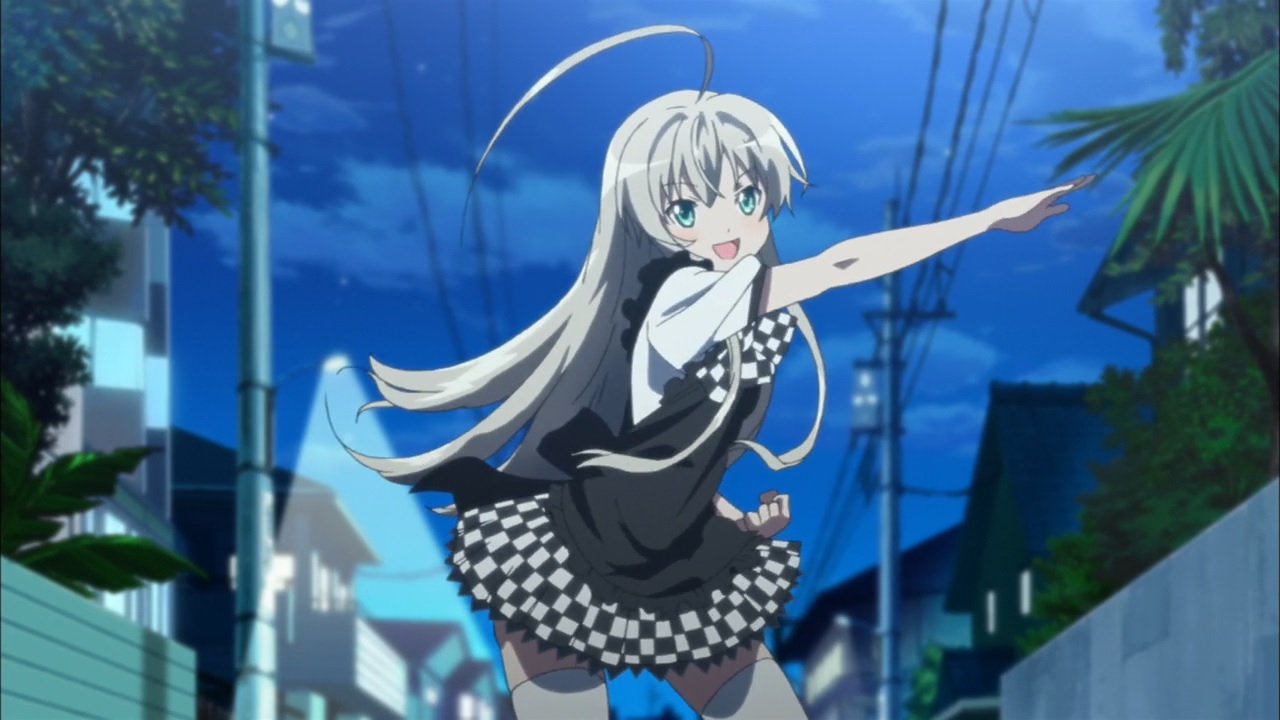
(1:06)
Nyaruko's poses are referencing those of Kamen Rider 1 from "Kamen Rider" (仮面ライダー), a Japanese TV show about a masked super hero that aired from 1971 to 1973. Images for reference:

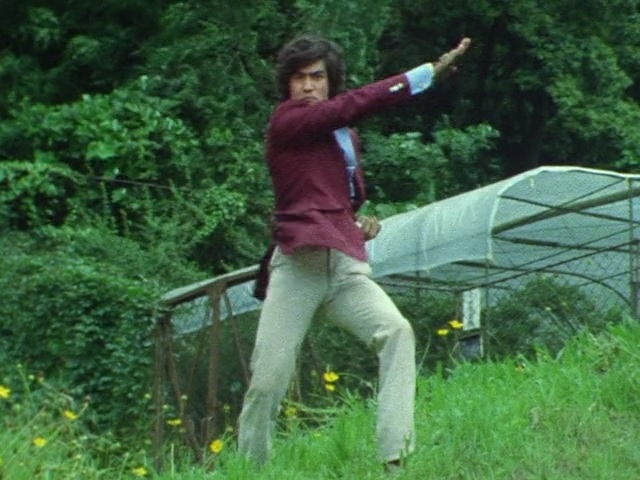


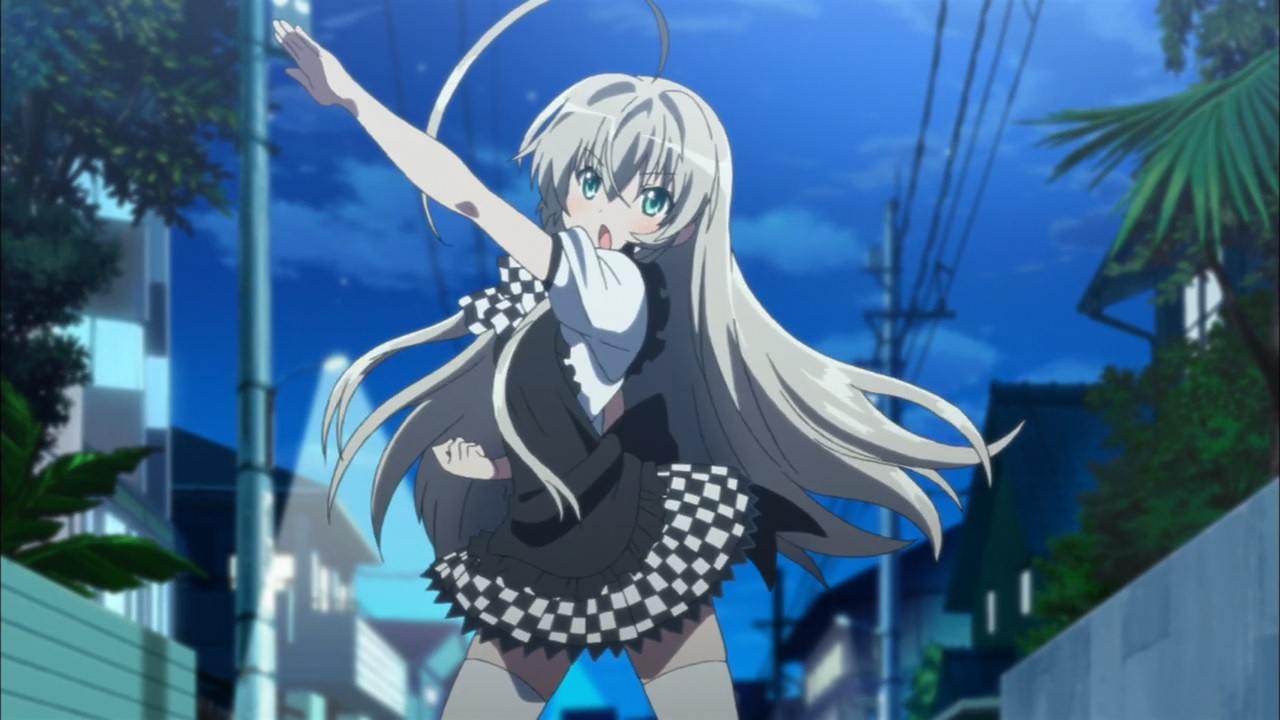
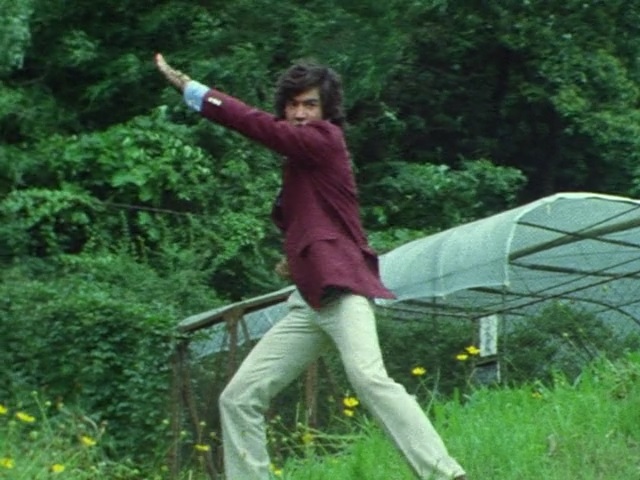

(2:45)
Mahiro's house has a gambrel roof. Buildings with such roofs often appear in the Cthulhu Mythos, like in the fictional city of Arkham, Massachusetts.S1 In "The Thing on the Doorstep", a short story written by H. P. Lovecraft and first published in 1937, a description of Arkham goes as follows:
What lay behind our joint love of shadows and marvels was, no doubt, the ancient, mouldering, and subtly fearsome town in which we lived—witch-cursed, legend-haunted Arkham, whose huddled, sagging gambrel roofs and crumbling Georgian balustrades brood out the centuries beside the darkly muttering Miskatonic.
"But having potato chips in the morning is good, too." (3:01)
The Japanese line is "Neoki ni potetochippusu mo ii mon desu kedo ne" (寝起きにポテトチップスも良いもんですけどね). "Neoki ni Potetochippusu" (寝起きにポテトチップス), "Potato Chips First Thing in the Morning", is the title of a web radio show hosted by Asumi Kana (阿澄佳奈) and Matsuki Miyu (松来未祐), the voice actors of Nyaruko and the later to appear Cthuko respectively.S1 The official website can be viewed here: http://www.hobirecords.com/potato/
Song (3:09)
The song that plays at this time is a brief excerpt from "Kurogane no Sutoraibaa" (黒鋼のストライバー), "Iron Striver", a song sung by Kitamura Eri (喜多村英梨) and Hatano Wataru (羽多野渉), the voice actors of Mahiro and the later to appear Yoichi respectively. The song was released on the "Taiyou Iwaku Moeyo Kaosu" (太陽曰く燃えよカオス) CD single.
"The Iron Striver, Star Vampire Crusaders!" (3:15)
There are two references here:
* "Sutaa Vanpaia Kuruseidaazu!" (スターヴァンパイアクルセイダーズ), "Star Vampire Crusaders", is referencing "Jojo no Kimyou na Bouken" (ジョジョの奇妙な冒険), "Jojo's Bizarre Adventure", a manga series written by Araki Hirohiko (荒木飛呂彦) and published starting from 1987. The title of the third story arc of this series is "Sutaadasuto Kuruseidaasu" (スターダストクルセイダース), which translates to "Stardust Crusaders".S1
* Star Vampire is a species of creature in the Cthulhu Mythos.S1

(3:20)
There are three references here:
* The figure on the table appears to be referencing Nadia (ナディア) from "Fushigi no Umi no Nadia" (ふしぎの海のナディア), "Nadia: The Secret of Blue Water", an anime series that aired from 1990 to 1991.S3 Image for reference:
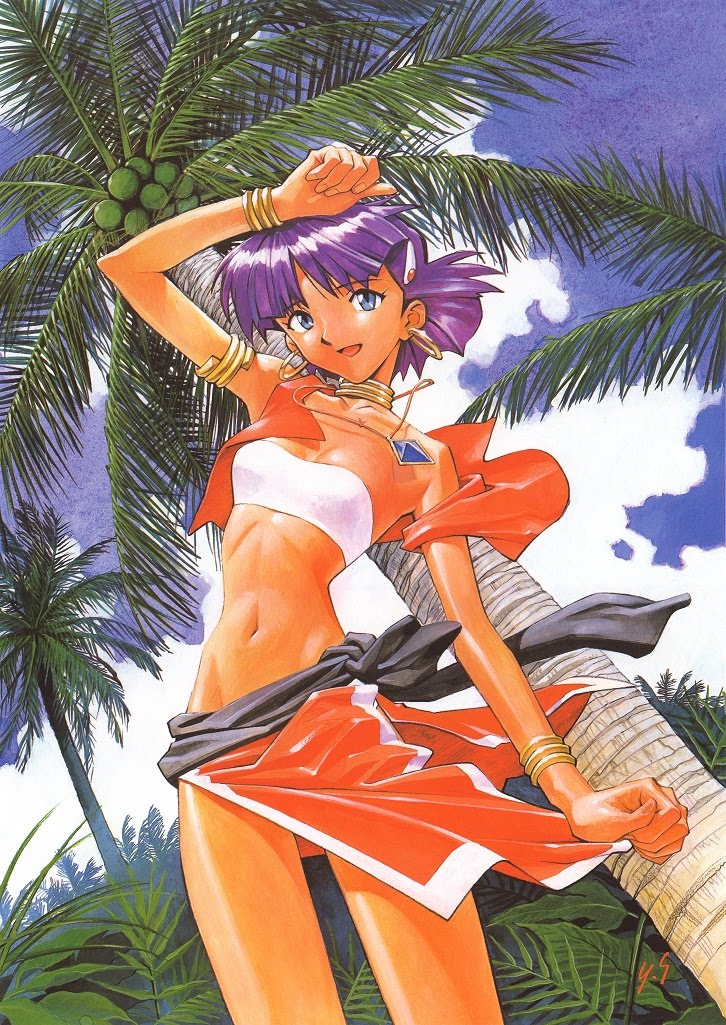
* The red speech bubble next to the figure is referencing "Azumanga Daioh" (あずまんが大王), a manga series written by Azuma Kiyohiko (あずまきよひこ) and published from 1999 to 2002. In particular, the yellow text within a red speech bubble appears to be referencing the same color scheme used for the title of the anime adaptation of this series that aired in 2002. In addition, the big 「あ」 character within the speech bubble is referencing how at times in this series characters have been depicted with a speech bubble containing the character 「あ」. Images for reference:
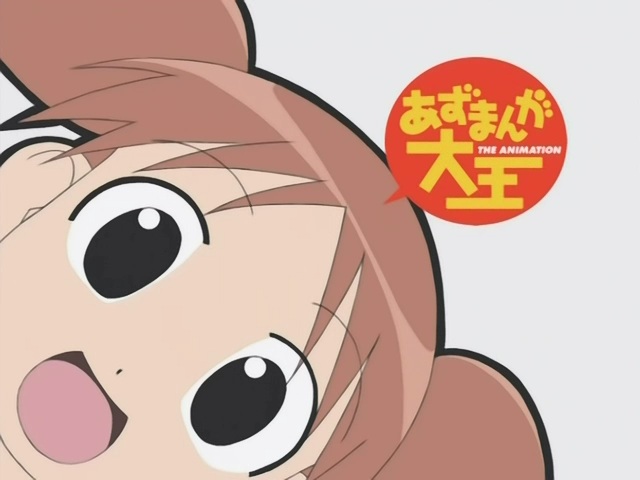

* The text within the speech bubble says "Ia Ia!" (いあいあ!). "Iä" is a term that is used in the Cthulhu Mythos, often in relation to the fantastic creatures that appear in the mythos.S2 In "The Shadow Over Innsmouth", a story written by H. P. Lovecraft and first published in 1936, a chant using the term goes as follows:
"Iä! Iä! Cthulhu fhtagn! Ph’nglui mglw’nafh Cthulhu R’lyeh wgah-nagl fhtagn"

(3:30)
The figure on the table is referencing Nyarlathotep (ないあるらとほてっぷ) from "Igyou tachi ni yoru to sekai ha..." (異形たちによると世界は・・・), "The World According to the Damned", a manga written by coco and published in 2011.S1 Image for reference:
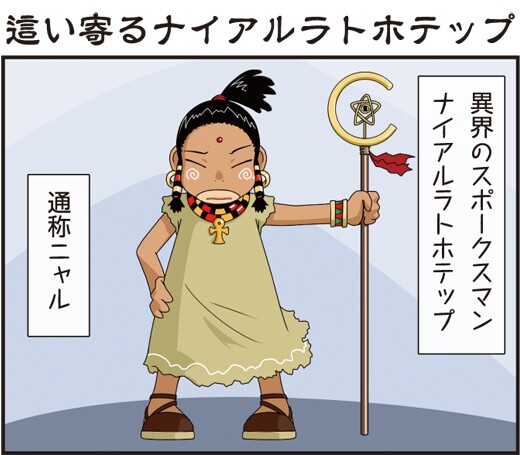
Source of image: https://bookwalker.jp/dec37d161a-6c72-480d-8619-d19f0becd93a/
(3:45)
Mahiro's fork appears to be referencing "Utawarerumono Radio" (うたわれるものらじお), a web radio show that aired in 2006.S1 The radio show promoted "Utawarerumono" (うたわれるもの), an anime series that aired in 2006, and was hosted by Koyama Rikiya (小山力也) and Yuzuki Ryoka (柚木涼香). According to the Utawarerumono Radio wiki site, in episode 4 of the radio show Sawashiro Miyuki (沢城みゆき) joined the show as a guest and brought a cake for everyone to share. Yuzuki, jealous of Koyama paying so much attention to Sawashiro, stabbed Koyama with a fork used to eat the cake. This has since become recognized as a weapon of Yuzuki's and a popular meme in Japan. In episode 18 of the radio show, Yuzuki was given a fork as a present from the listeners.
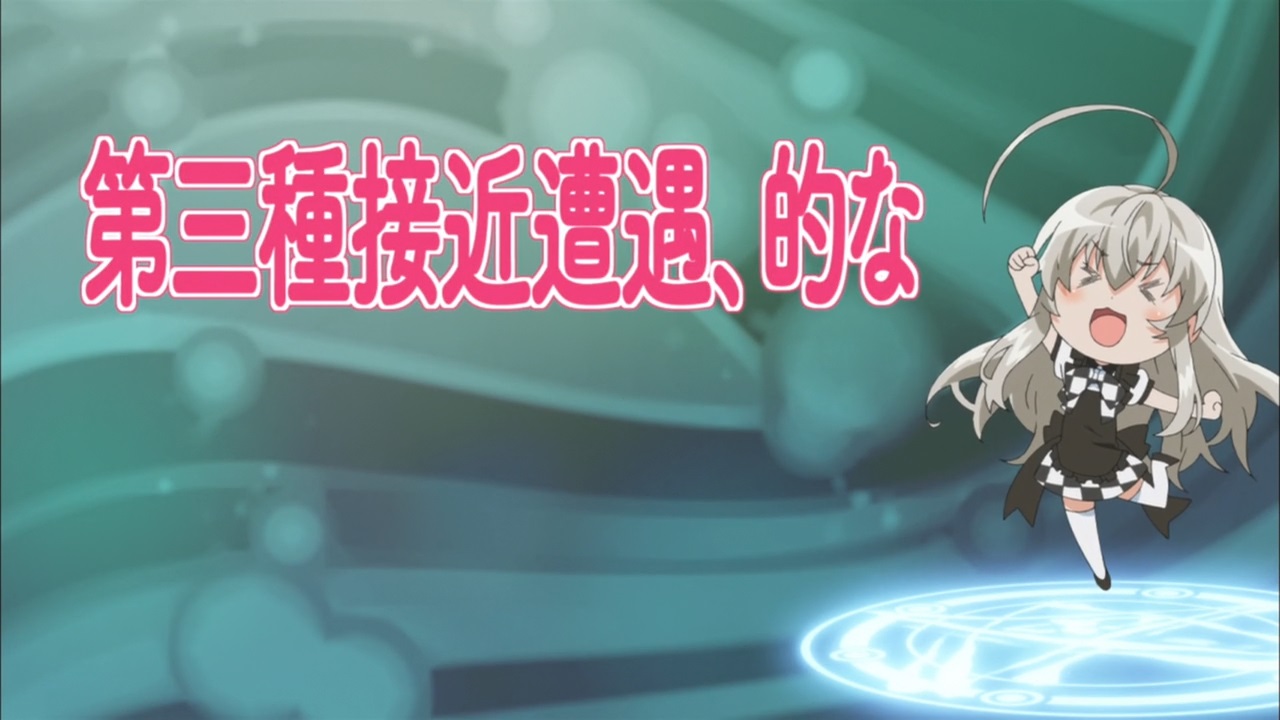
(3:51)
There are two references here:
* The title of this episode is "Dai San Shu Sekkin Souguu, Teki na" (第三種接近遭遇、的な), which translates to "Like a Close Encounter of the Third Kind". "Close Encounters of the Third Kind" is a term that describes a UFO encounter in which an animated entity is present. This term is a part of the "Close Encounter" classification system that was published by J. Allen Hynek in 1972.S4 On a related note, "Close Encounters of the Third Kind" is the title of a movie released in 1977 that is based on this concept.S4
* The symbol underneath Nyaruko is referencing August Derleth's description the Elder Sign, a symbol that appears in the Cthulhu Mythos.S7 Descriptions of the Elder Sign are stated in "The Lurker at the Threshold", a story written by H. P. Lovecraft and August Derleth and first published in 1945. One such description goes as follows:
"Its decoration, however, did not follow the motif of the bas-relief figures, but was, rather, in the rough shape of a star, in the center of which there appeared to be a caricature of a single giant eye; but it was not an eye, rather a broken lozenge in shape with certain lines suggestive of flames or perhaps a solitary pillar of flame."Another description goes as follows:
"a rough star of five points, centered with a broken lozenge framing what appeared to be a pillar of flame."Image from the 5th edition rule book for the "Call of Cthulhu" RPG for reference:

To note, while "The Lurker at the Threshold" is credited to both H. P. Lovecraft and August Derleth, the story is primarily written by Derleth. An excerpt from S.T. Joshi's "H.P. Lovecraft: A Comprehensive Bibliography" states, "In some instances Derleth incorporated actual prose passages by Lovecraft into his stories. The Lurker at the Threshold (a 50,000-word novel) contains about 1,200 words by Lovecraft". Therefore, the contents of "The Lurker at the Threshold", including the descriptions of the Elder Sign, are attributed to Derleth.
"Gaplant!" (3:52)
Nyaruko yelp #1. Gaplant (ギャプラン) is the name of a combat vehicle from "Mobile Suit Zeta Gundam" (機動戦士Ζガンダム), an anime series that aired from 1985 to 1986.S9

~< `・ω・´> (4:05)
The white creature on the snack wrappings is the Twitter profile picture of Aisora Manta (逢空万太), the author of the "Haiyore! Nyaruko-san" light novel series.S1 Screen capture for reference:

"I am Nyarlathotep. I'm the Crawling Chaos." (4:20)
Nyaruko (ニャル子) is based on Nyarlathotep, a creature classified as an Outer God in the Cthulhu Mythos. It is referred to as "the crawling chaos" in "Nyarlathotep", a short story written by H. P. Lovecraft and first published in 1920.
"I've read Lovecraft's books before," (4:33)
This is referencing H. P. Lovecraft, the author whose works led to the creation of the Cthulhu Mythos that "Haiyore! Nyaruko-san" is based on.

(4:37)
The background bears great resemblance to Piet Mondrian's "Composition" series of paintings.S2 "Composition A" by Piet Mondrian:
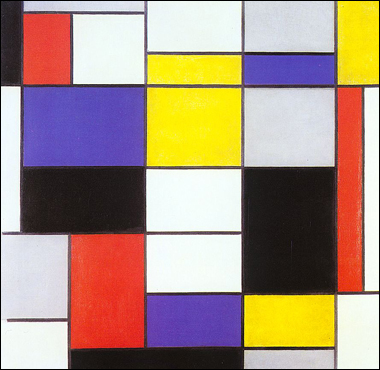
Source of image: http://emptyeasel.com/2007/04/17/piet-mondrian-the-evolution-of-pure-abstract-paintings/
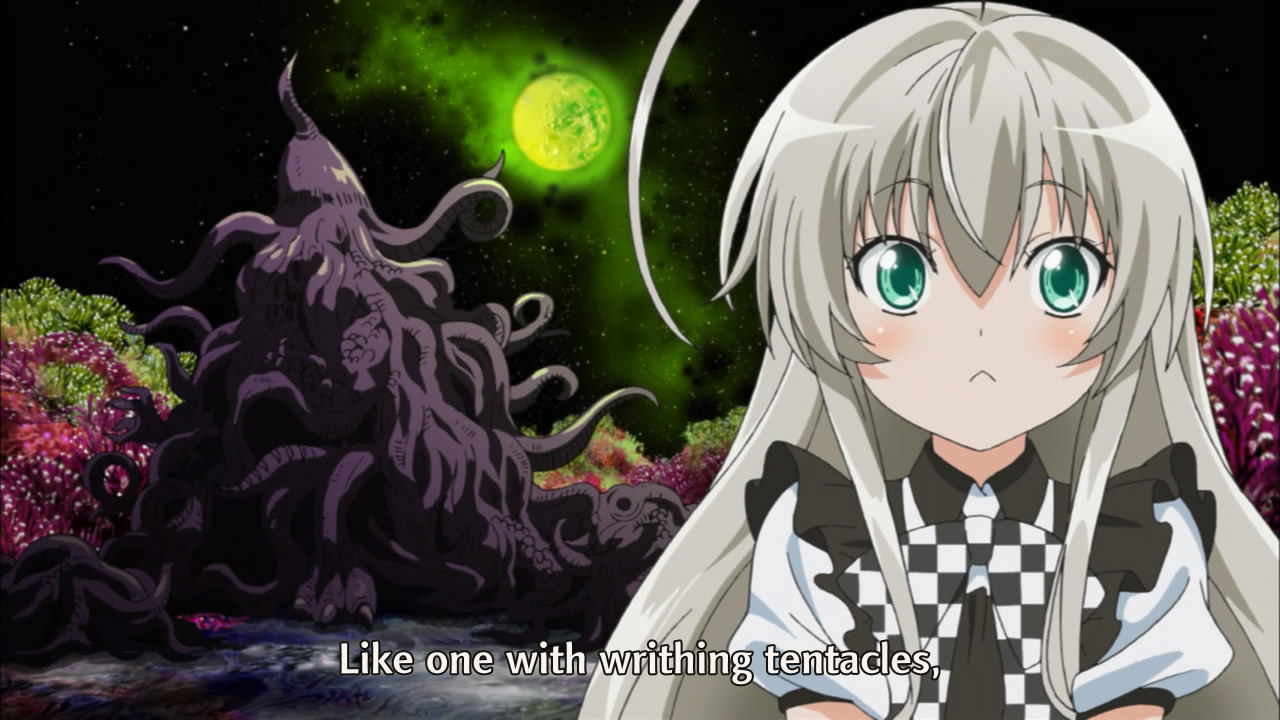
"Like one with writhing tentacles" (4:40)
The image and description are referencing an avatar of Nyarlathotep known as the Dweller in Darkness. In "The Dweller in Darkness", a short story written by August Derleth and first published in 1944, it is described as follows:
"We arrived at the belt of trees around the slab while afterglow yet lingered in the western heavens, and by the illumination of a flashlight Laird carried, we examined the face of the slab itself, and the carving on it: of a vast, amorphous creature, drawn by an artist who evidently lacked sufficient imagination to etch the creature's face, for it had none, bearing only a curious, cone-like head which even in stone seemed to have a fluidity which was unnerving; moreover, the creature was depicted as having both tentacle-like appendages and hands—or growths similar to hands, not only two, but several; so that it seemed both human and non-human in its structure. Beside it had been carved two squat squid-like figures from a part of which—presumably the heads, though no outline was definitive—projected what must certainly have been instruments of some kind, for the strange, repugnant attendants appeared to be playing them."Another description from the story goes as follows:
"For, where but a moment before there had been nothing, there was now a gigantic protoplasmic mass, a colossal being who towered upward toward the stars, and whose actual physical being was in constant flux; and flanking it on either side were two lesser beings, equally amorphous, holding pipes or flutes in appendages and making that demoniac music which echoed and reechoed in the enclosing forest. But the thing on the slab, the Dweller in Darkness, was the ultimate in horror; for from its mass of amorphous flesh there grew at will before our eyes tentacles, claws, hands, and withdrew again; the mass itself diminished and swelled effortlessly, and where its head was and its features should have been there was only a blank facelessness all the more horrible because even as we looked there rose from its blind mass a low ululation in that half-bestial, half-human voice so familiar to us from the record made in the night!"Here is an artist's rendition of the Dweller in Darkness for reference:
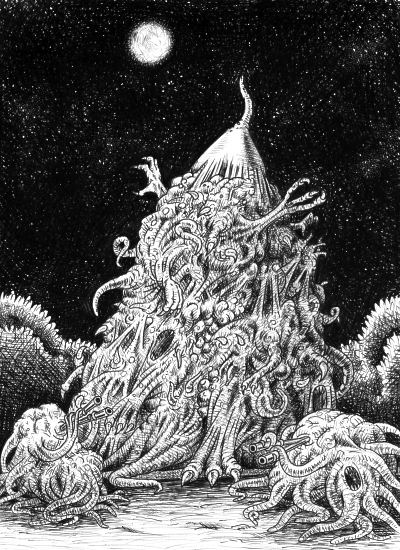
Source of image: https://en.wikipedia.org/wiki/File:Nyarlathotep.jpg
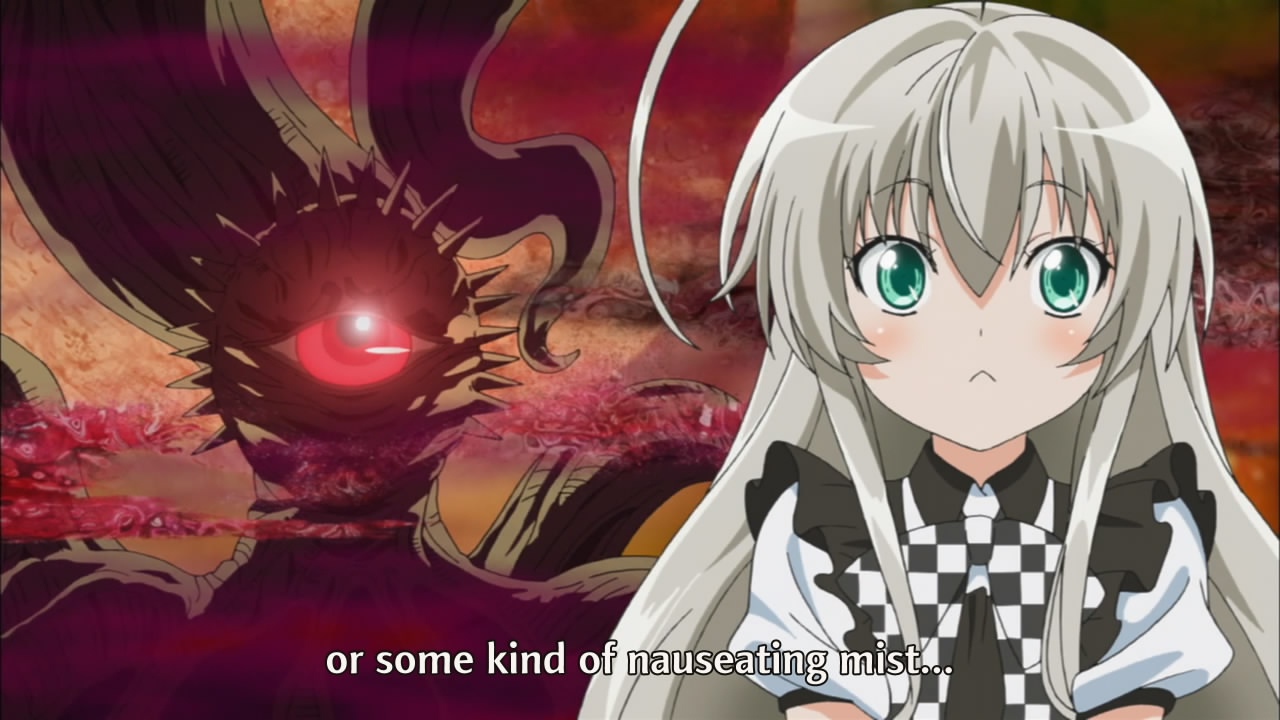
"or some kind of nauseating mist." (4:43)
The image and description are referencing an avatar of Nyarlathotep known as the Crawling Mist.S2 In "Elysia", a novel written by Brian Lumley and first published in 1989, it is described as follows:
"... the Crawling Chaos dissolved into dank mist which writhed away into the crevices of the west-leading tunnel and was gone."
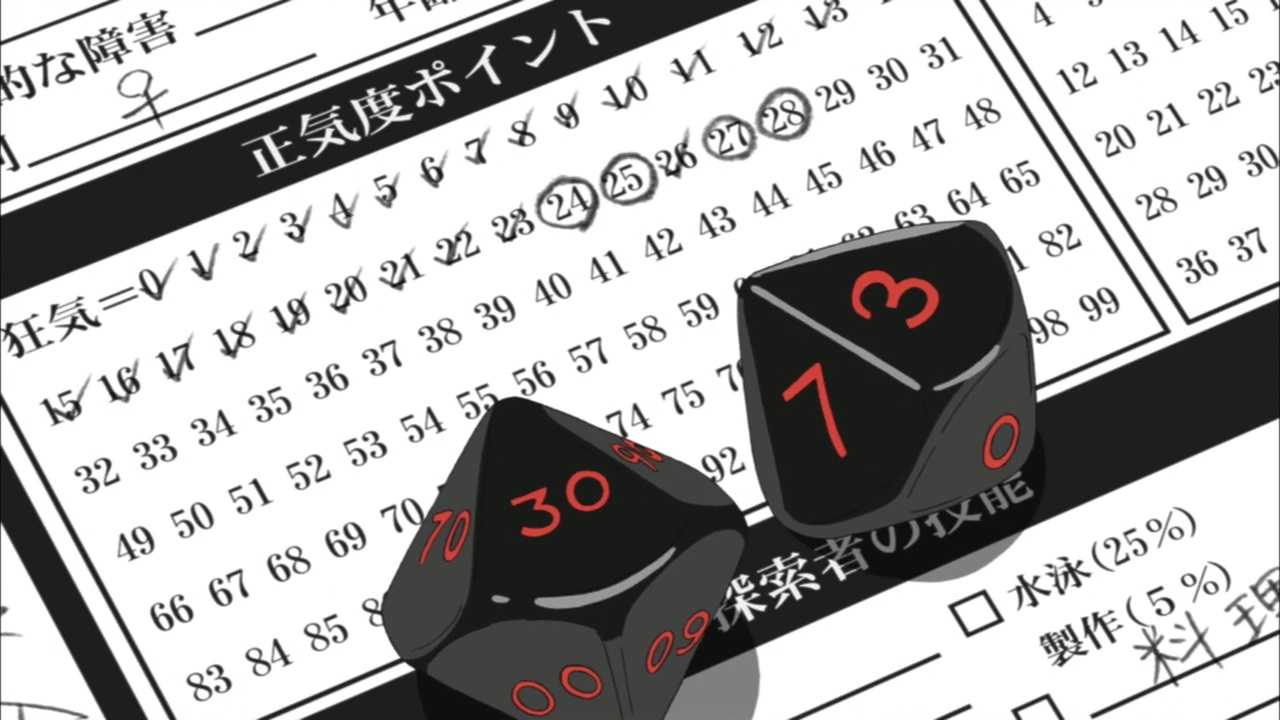
"If you'd like, I can take one of those forms, but your sanity points would drop." (4:45)
There are four references here:
* This is referencing "Call of Cthulhu", a tabletop role playing game first published in 1981 by Chaosium. According to the "Call of Cthulhu" 6th Edition Rulebook, each player's character has a numerical parameter called "Sanity", abbreviated as "SAN", that represents the character's "flexibility and resilience to emotional trauma". This number is the upper limit for a character's Sanity Points, which represent the character's current level of sanity. In the game, whenever a character encounters a sanity threatening situation, the player controlling that character does a sanity roll, a dice roll to determine the amount of sanity points lost from the encounter. If the roll is successful, depending on what was encountered, the character loses either a minimal amount of sanity points or none at all. If the roll is unsuccessful, the character typically loses a large amount of sanity points. If a character's sanity points drop to zero, the character is permanently insane and normally can no longer be played.
* According to the "Call of Cthulhu" 6th Edition Rulebook, no sanity points are lost from seeing Nyarlathotep in his human form. However, seeing many of his other 999 forms results in 10 sanity points lost on a successful sanity roll, and 100 sanity points lost on a failed sanity roll. A character's maximum possible sanity is 99, so a failed sanity roll upon seeing one of Nyarlathotep's non-human forms will always result in the character going insane.
* The character sheet that appears here is based on the character sheet from the "Call of Cthulhu" role playing game. Here is a character sheet from the 5th Edition Rulebook for reference:
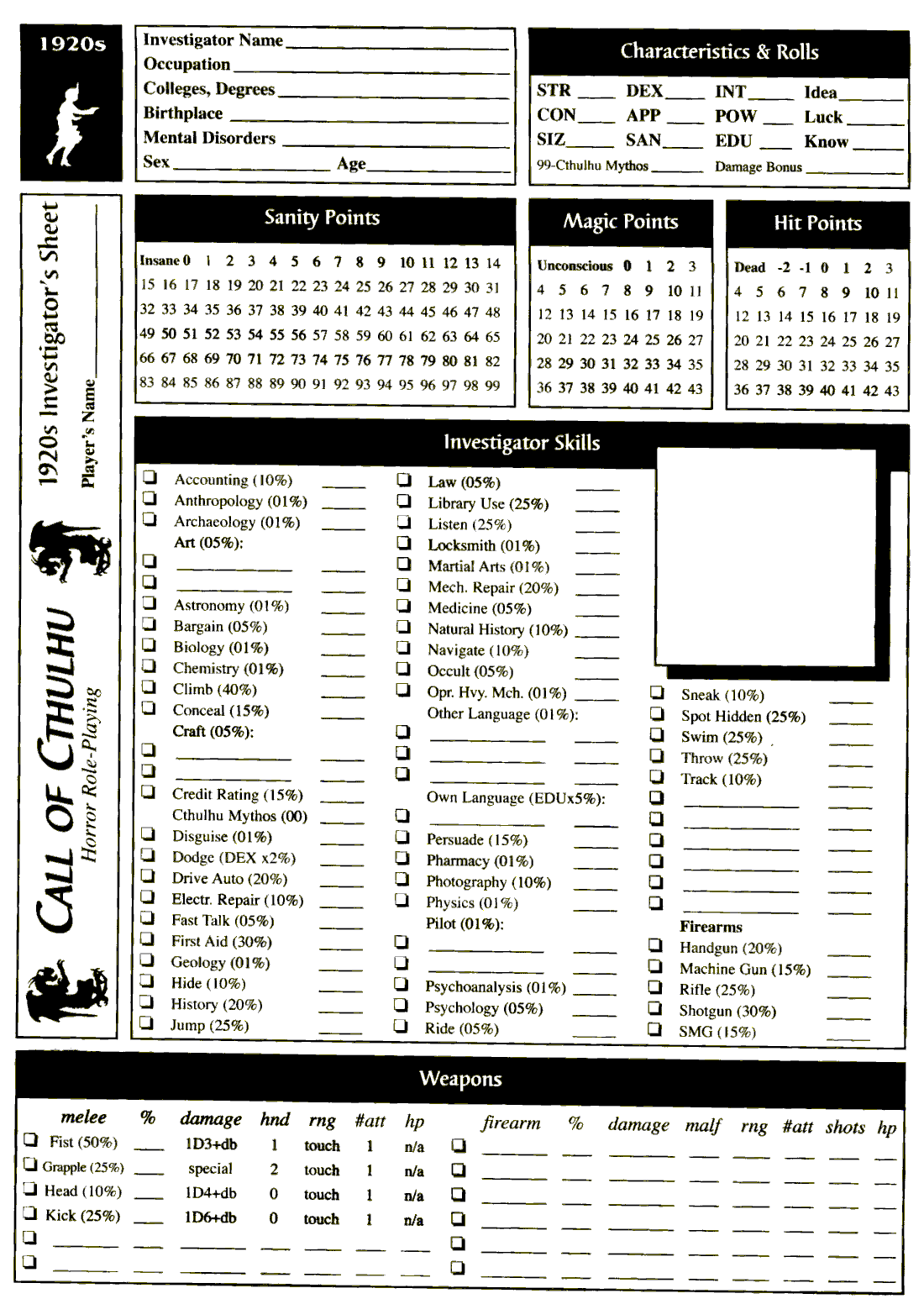
* More specifically, the character sheet that appears here is based on the character sheet of Anjinduka Miyako (安針塚京(あんじんづか・みやこ)) from "Ruruie Antiiku" (るるいえあんてぃーく), "R'lyeh Antique", an RPG replay book based on the "Call of Cthulhu" RPG that was written by Uchiyama Yasujirou (内山靖二郎) and published in 2009.S7 The situation in which all sanity points are lost is also a reproduction of what occurs to Miyako in chapter 3 of "R'lyeh Antique" when she goes insane.S12 In addition, the book's author, Uchiyama, has also confirmed this reproduction on his blog website, and posted an image of Miyako's actual character sheet that he used while writing the book. Image for reference:
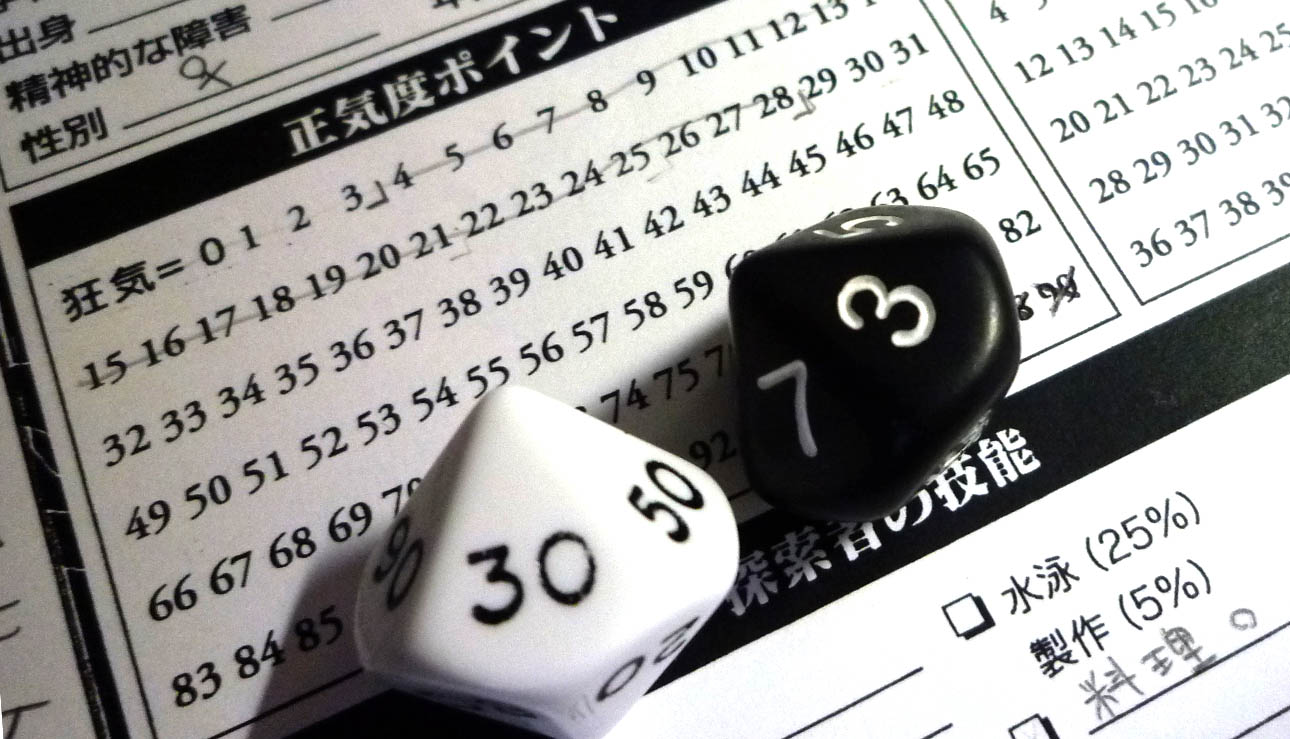
Source of image: http://hikidashinonakami.cocolog-nifty.com/blog/2012/04/post-d675.html
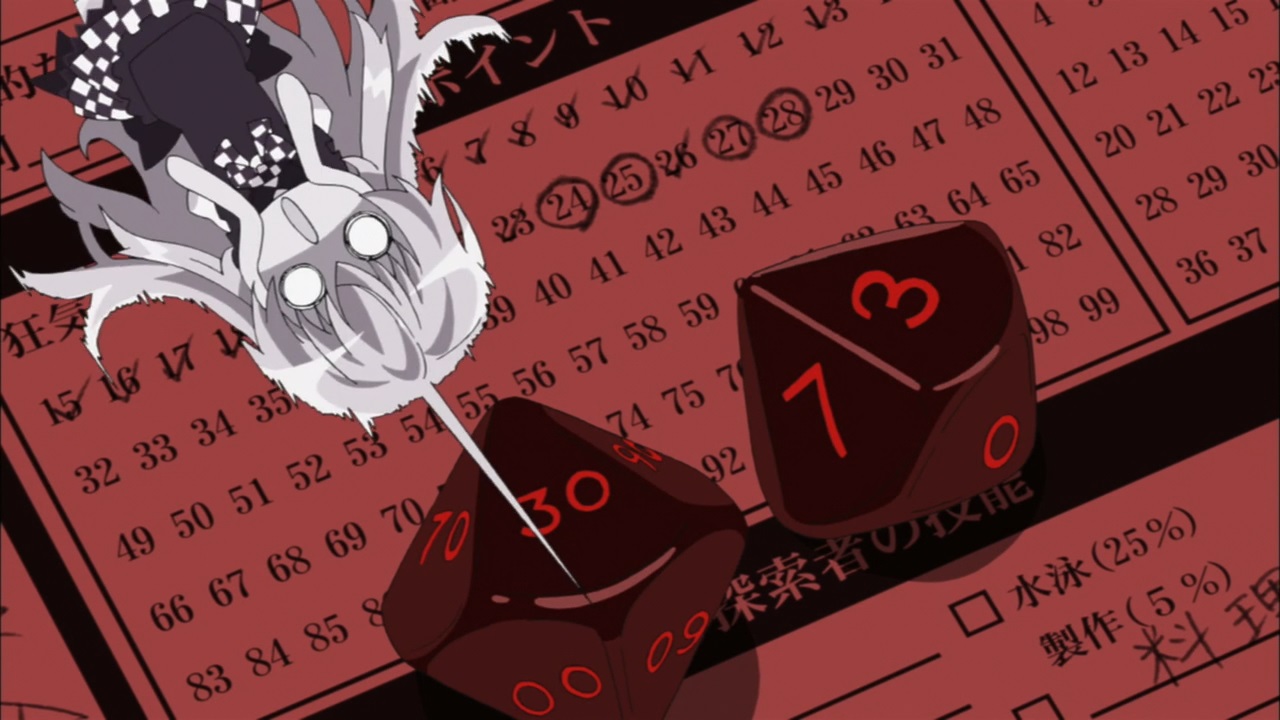
(4:52)
Nyaruko's pose and expression are referencing "The Scream", a painting painted by Edvard Munch in 1893. Image for reference:
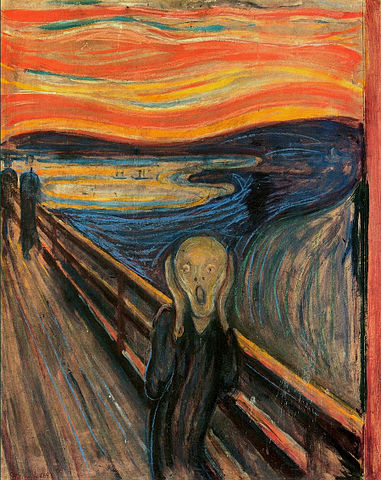
Source of image: https://en.wikipedia.org/wiki/File:The_Scream.jpg
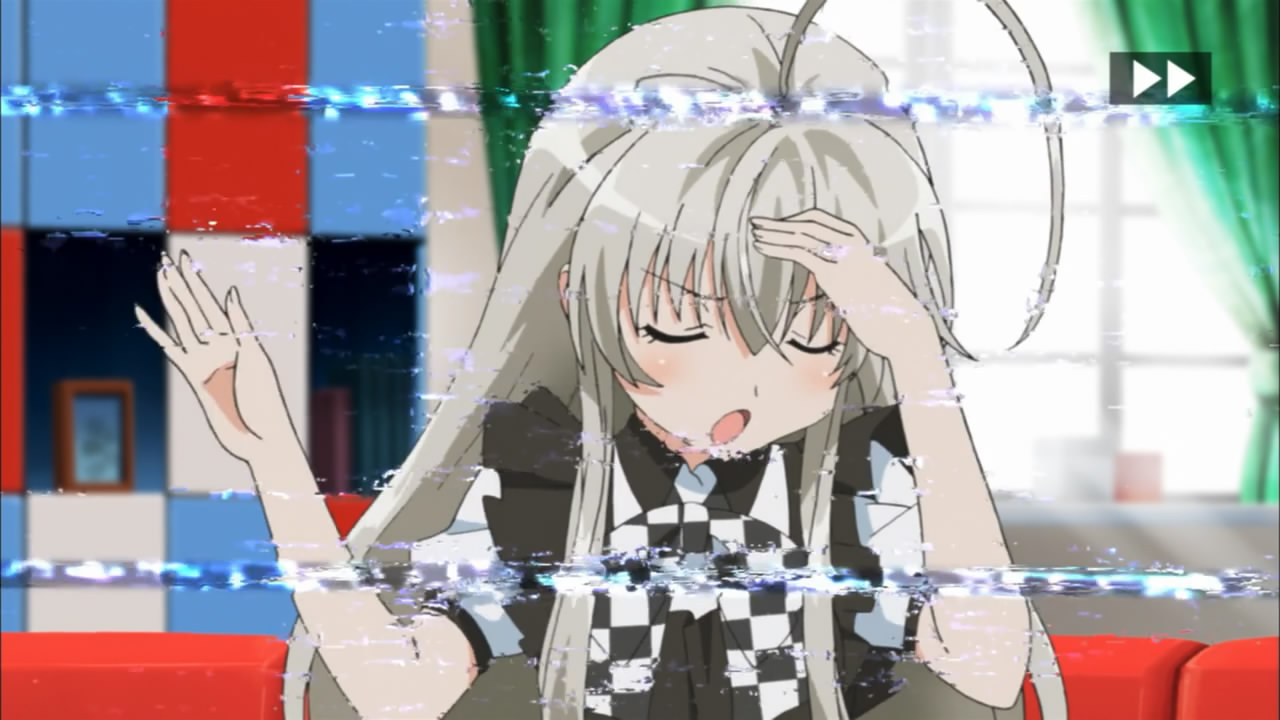
(5:09)
If this fast forwarded scene is slowed down to 50% speed, Nyaruko actually speaks understandable Japanese.S10 Her line goes as follows:
「これでも宮仕えなもので。いや、これがまた上司が居眠りばっかこく癖に人使いが荒い人でして、なのに自分が起こされると」Video for reference: https://youtube.com/watch?v=slA6VPuzkcw
"Kore demo miyadukae na mono de. Iya, kore ga mata joushi ga inemuri bakka koku kuse ni hitodukai ga arai hito de shite, nano ni jibun ga okosareru to"
"This is a company assignment kind of job. Ah, my boss has a strict way of handling employees even though he dozes off all the time, and if he is woken up..."
Nyaruko says almost the same thing on page 19 of volume 1 of the "Haiyore! Nyaruko-san" light novel series.S2 In the novel, Nyaruko continues speaking for quite a while. The end of that sentence, however, goes as follows:
「宇宙が吹っ飛ぶくらい怒る人なんですよ。」On a related note, the fast forwarding animation is the way a video display appears when fast forwarding a VHS tape.S1
"uchuu ga futtobu kurai okoru hito nan desu yo."
"... he gets angry enough that the universe gets blown away."

(5:15)
There are three references here:
• There is a device that is based on the Panasonic FZ-1 R·E·A·L 3DO Interactive Multiplayer (スリーディーオー), a video game console released by The 3DO Company in 1993.S1 Image for reference:
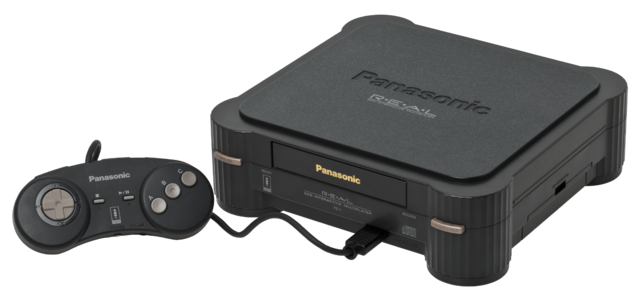
Source of image: https://en.wikipedia.org/wiki/File:3DO-FZ1-Console-Set.png
• There is a device that is based on the Pippin atmark (ピピンアットマーク), a video game console released by Apple Computer (アップル) and Bandai (バンダイ) in 1996.S1 Image for reference:

Source of image: https://en.wikipedia.org/wiki/File:Pippin-Atmark-Console-Set.jpg
• There is a device that is based on the Mega Drive (メガドライブ), also known as the Sega Genesis, a video game console released by SEGA (セガ) in 1988.S1 Image for reference:
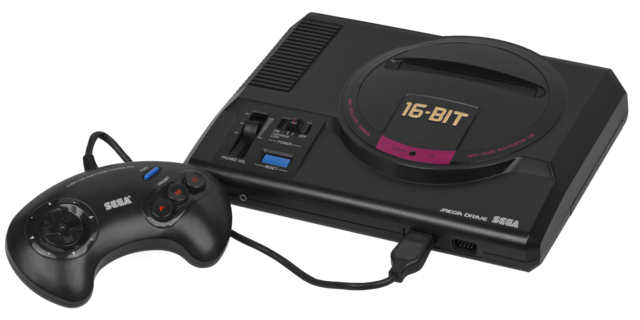
Source of image: https://en.wikipedia.org/wiki/File:Sega-Mega-Drive-JP-Mk1-Console-Set.png
"We're aliens." (5:38)
The Japanese line is "Wareware ha uchuujin da" (我々は宇宙人だ). This is a cliche line for aliens that was first used in "Chikyuu Boueigun" (地球防衛軍), "Earth Defense Force", a Japanese movie released in 1957.S2
"From 'good morning' until 'good night.'" (6:31)
The Japanese line is "Ohayou kara oyasumi made" (おはようからおやすみまで). This is a catch phrase used in TV commercials for Lion Corporation, a Japanese company that specializes in healthcare and household products.S1 Video for reference: https://youtube.com/watch?v=ZCqVTcv8ZNM
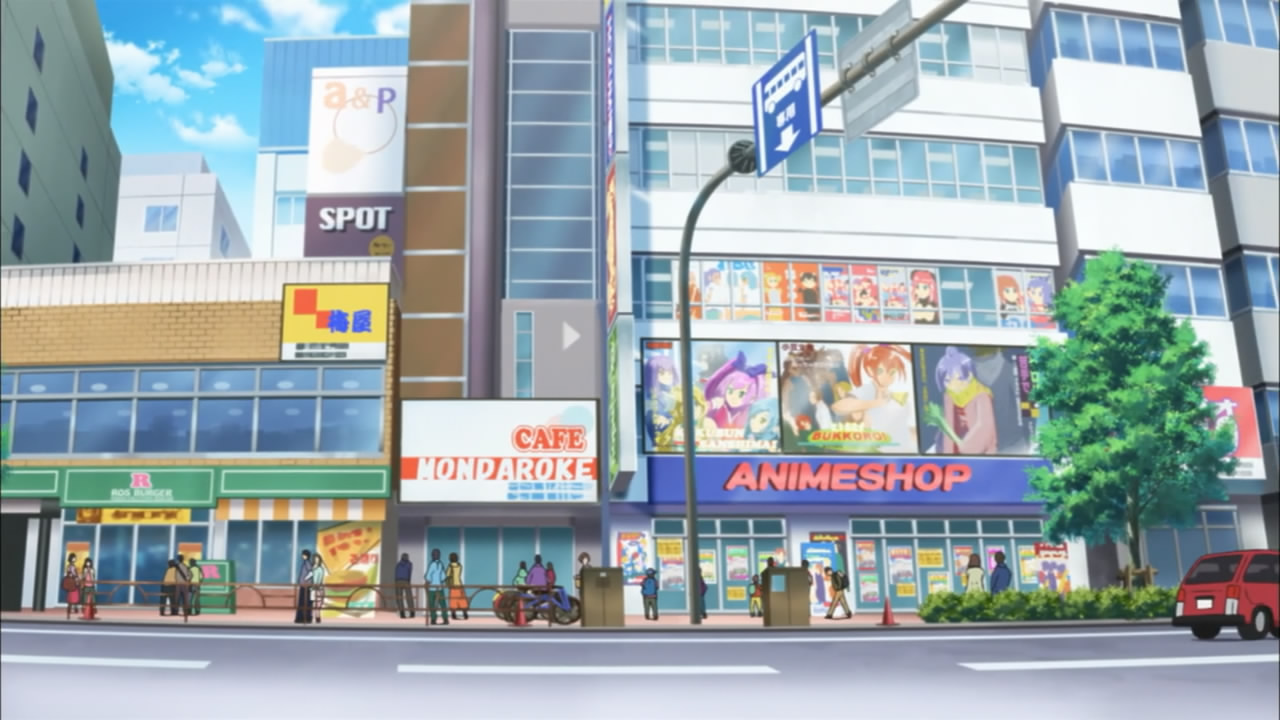
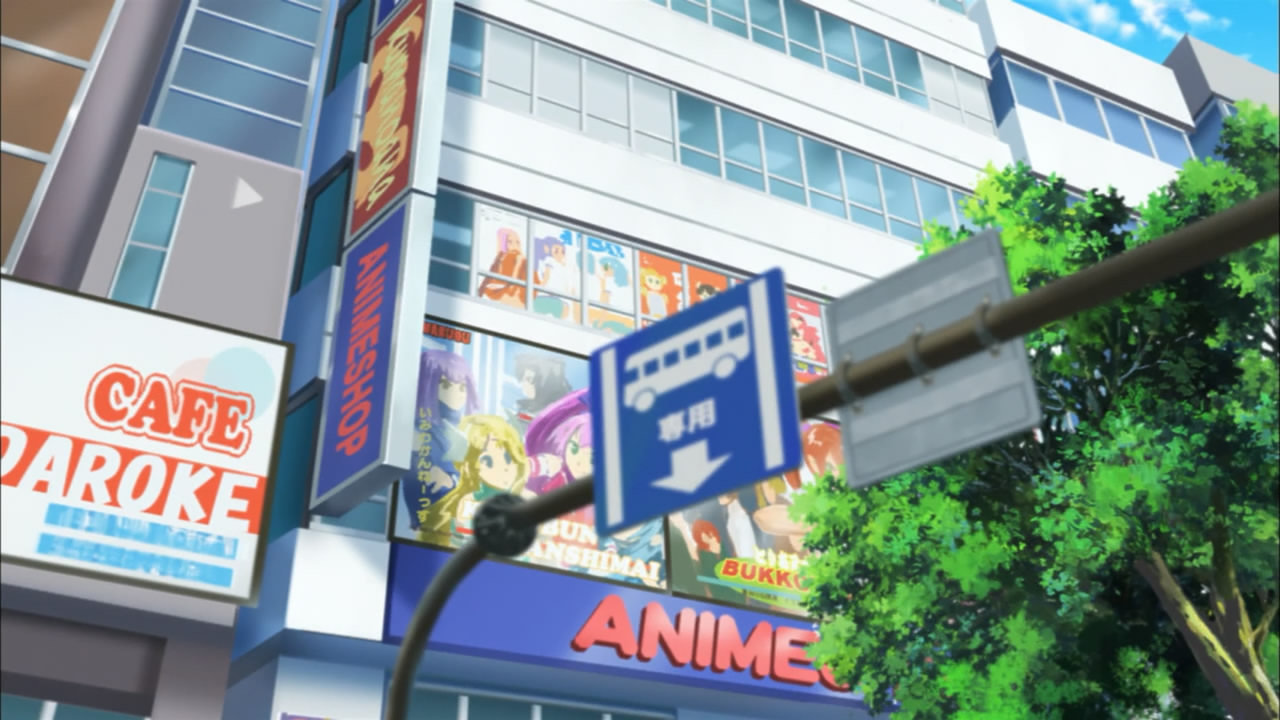
(7:08), (7:49)
There are five references here:
* There is a store with a sign that reads "ANIMESHOP". This is referencing animate (アニメイト), a Japanese retailer of anime, manga, and video games. In particular, the store front resembles the animate store in Sapporo.S2 Images for reference:


Source of images: http://beetle883.blog.fc2.com/blog-entry-104.html
* There is a restaurant with a sign that reads "ROS BURGER". This is referencing MOS BURGER (モスバーガー), a Japanese fast food restaurant chain. A MOS BURGER can also be seen in the above image.
* There is a store with a sign that reads "CAFE MONDAROKE". This is referencing Mandarake (まんだらけ), a Japanese retailer that sells used goods.S3
* There is a sign that reads "a&p". This is referencing "Bunka Housou A&G" (文化放送A&G), "Cultural Broadcasting A&G", a collection of Japanese radio programs that specialize in animation and game related content. A&G programs are managed and broadcasted by Bunka Housou (文化放送), Nippon Cultural Broadcasting, a Japanese broadcasting company. In addition, the appearance of the sign with a&p depicted with a circle appears to be referencing logo for A&G. Image for reference:
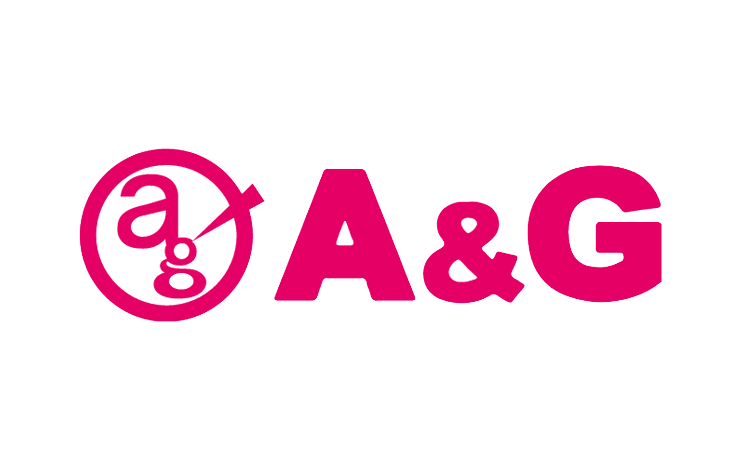
Source of image: https://www.joqr.co.jp/ag/
* In the second image, the vertical sign above the ANIMESHOP sign reads "kumanoana". Here is an edit of the kumanoana sign that may be easier to read:

This is referencing COMIC TORANOANA (コミックとらのあな), a Japanese retailer that sells manga related items. A sign for TORANOANA can also be seen in the second image of the animate store above.
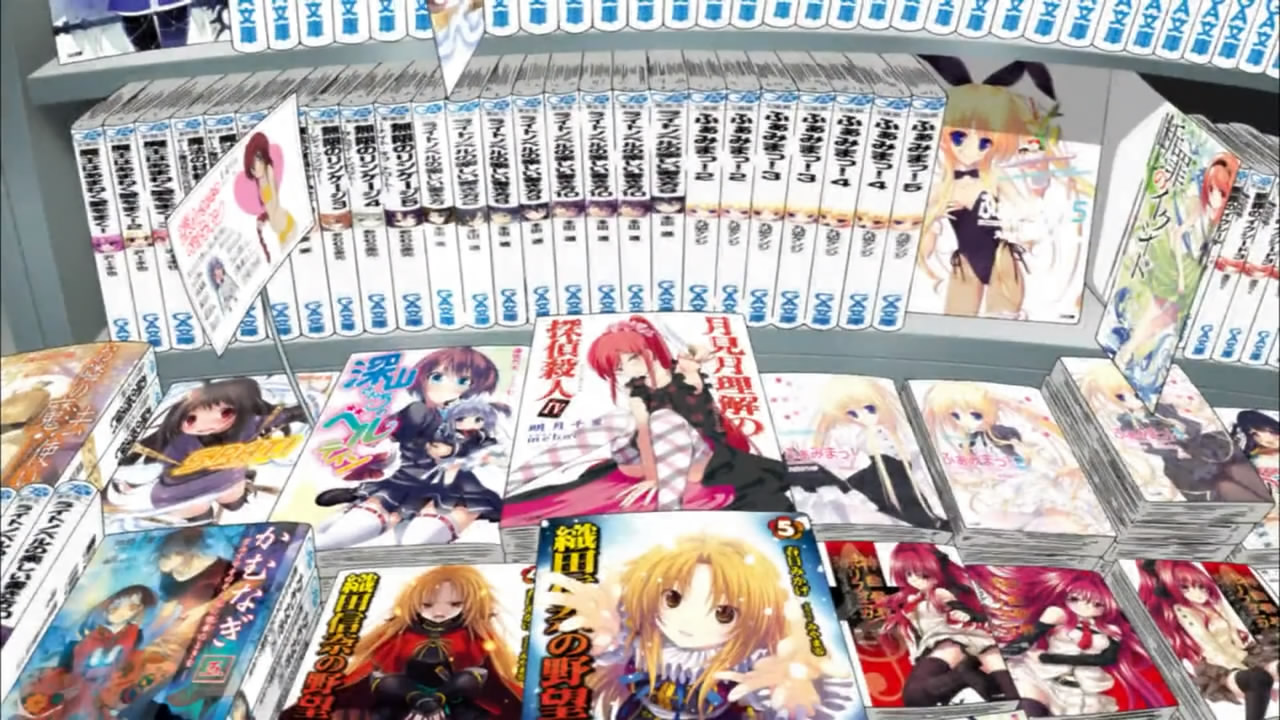
(7:12)
In this scene there are lots of shots of light novels shown. There are so many shown, that from here on each reference will not be shown except for some special cases. All the light novels that appear are published by the company GA Bunko (GA文庫), which also publishes the "Haiyore! Nyaruko-san" light novel series.S1
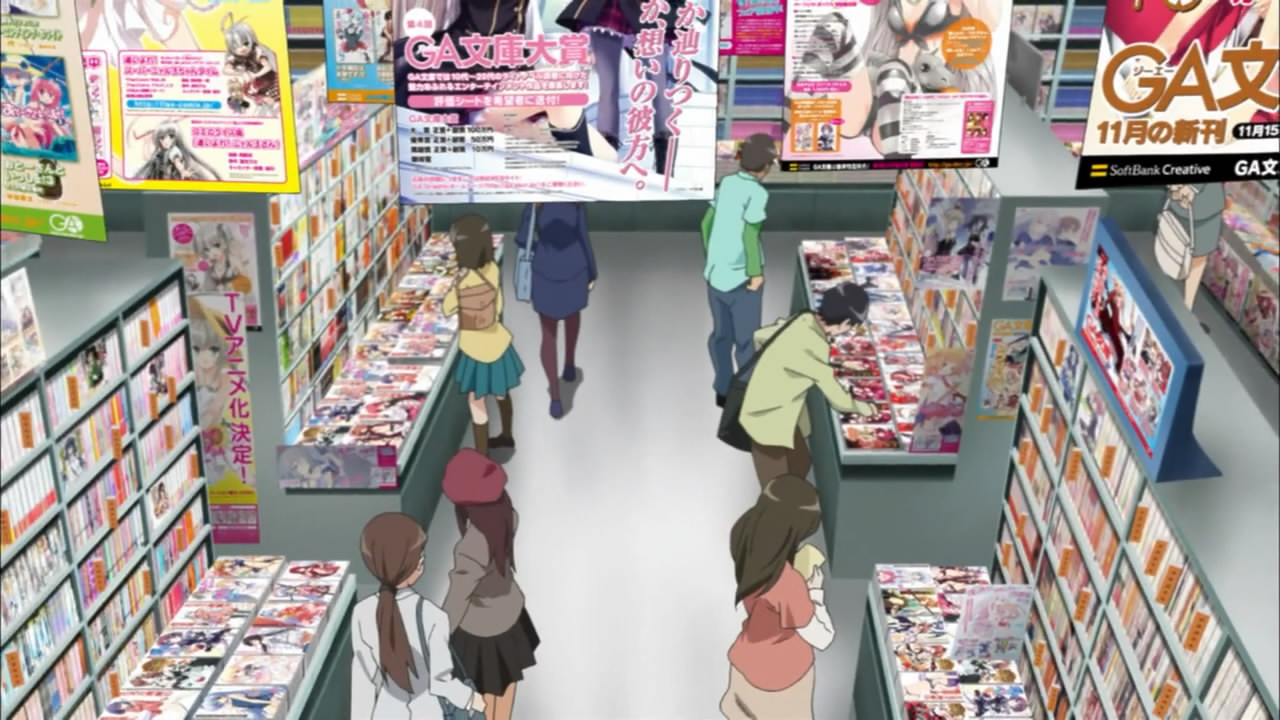
(7:15)
Lots of "Haiyore! Nyaruko-san" posters can be seen, all of which are based on official art. Also various other light novels are shown.
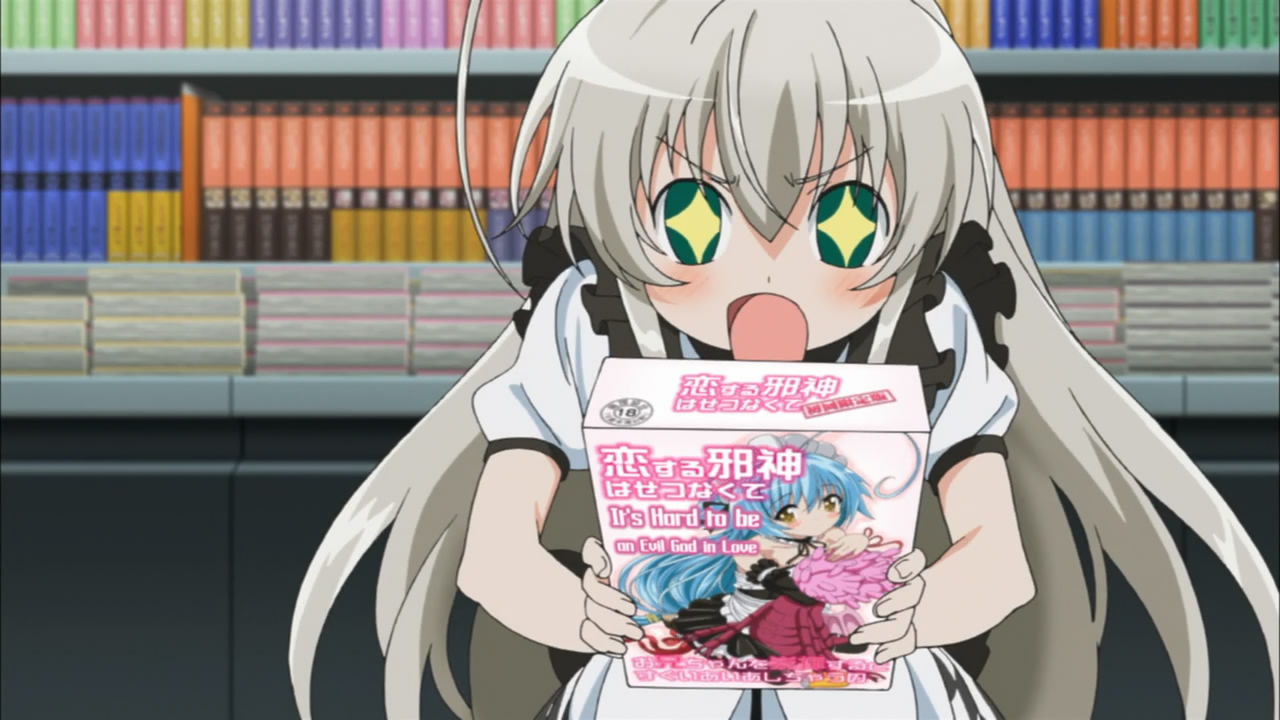
(7:36)
There are three references here:
* The cover art of the package is based on the cover art of volume 2 of "Makai Shoujo Ruruie Ruru" (魔海少女ルルイエ・ルル), "Girl From the Demonic Sea Ruruie Ruru", a light novel series written by Hazawa Kouichi (羽沢向一) and published in 2010.S1 Image for reference:
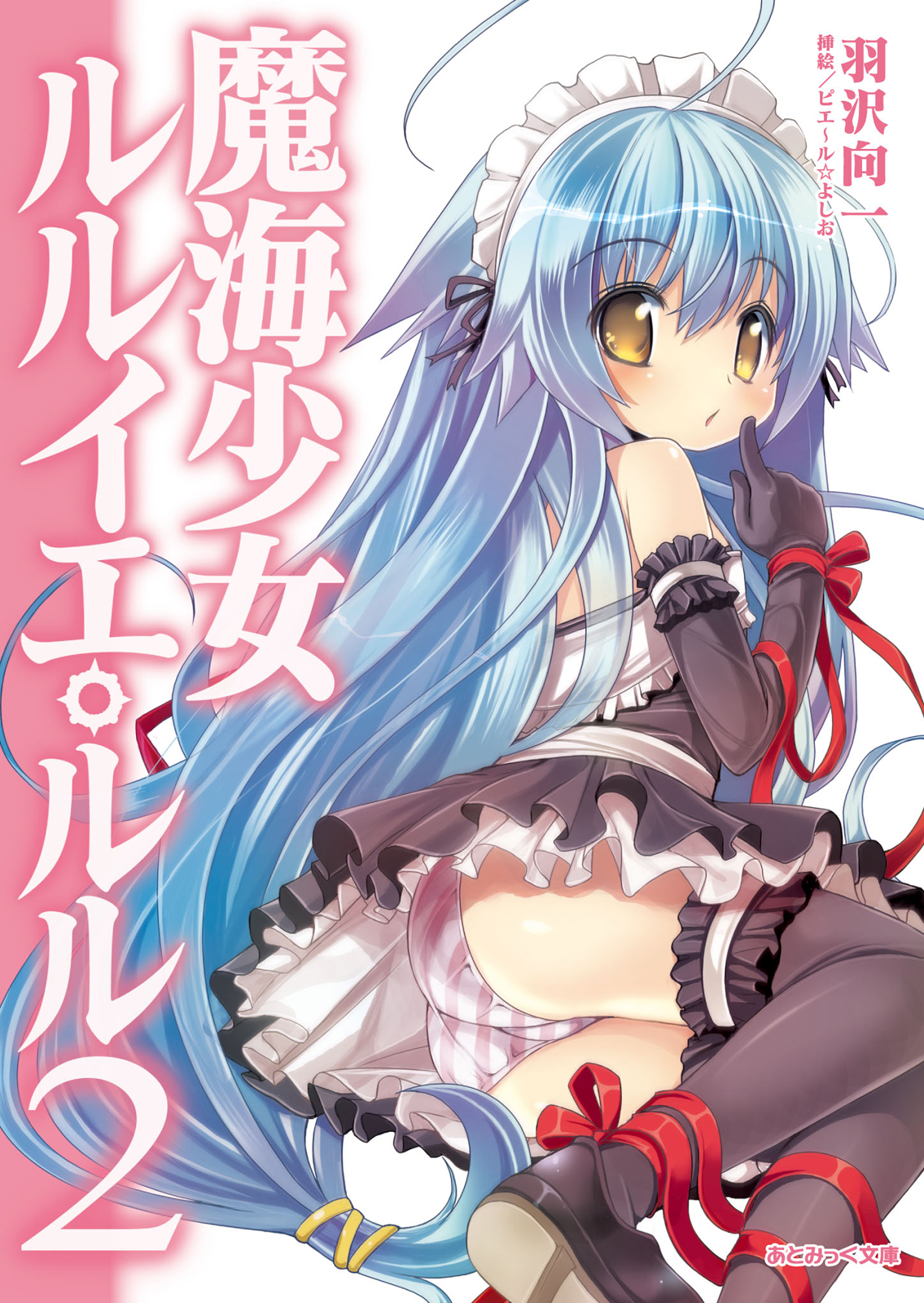
Source of image: https://bookwalker.jp/de7fbabf5d-dfc4-4c67-8169-e4dddfd058c5/
* The title of the game goes as follows:
「恋する邪神はせつなくてお兄ちゃんを崇拝するとすぐいあいあしちゃうの」"Iä" is a term that is used in the Cthulhu Mythos, often in relation to the fantastic creatures that appear in the mythos. In "The Shadow Over Innsmouth", a story written by H. P. Lovecraft and first published in 1936, a chant using the term goes as follows:
"Koi Suru Jashin ha Setsunakute Onii-chan wo Suuhai Suru to Sugu Ia Ia Shichau no"
"It's Hard to be an Evil God in Love, When I Worship Brother I Immediately Ia Ia"
"Iä! Iä! Cthulhu fhtagn! Ph’nglui mglw’nafh Cthulhu R’lyeh wgah-nagl fhtagn"The title as a whole is referencing the title of a visual novel released by CAGE in 2003.S4 The title of this visual novel goes as follows:
「恋する妹はせつなくてお兄ちゃんを想うとすぐHしちゃうの」* The creature that the girl on the cover is hugging is a Mi-go, a species of creature in the Cthulhu Mythos. In "The Whisperer in Darkness", a short story written by H. P. Lovecraft and first published in 1931, it is described as follows:
"Koi Suru Imouto ha Setsunakute Onii-chan wo Omou to Sugu H Shichau no"
"It's Hard to be a Little Sister in Love, When I Think of Brother I Immediately Get Aroused"
"They were pinkish things about five feet long; with crustaceous bodies bearing vast pairs of dorsal fins or membraneous wings and several sets of articulated limbs, and with a sort of convoluted ellipsoid, covered with multitudes of very short antennae, where a head would ordinarily be."
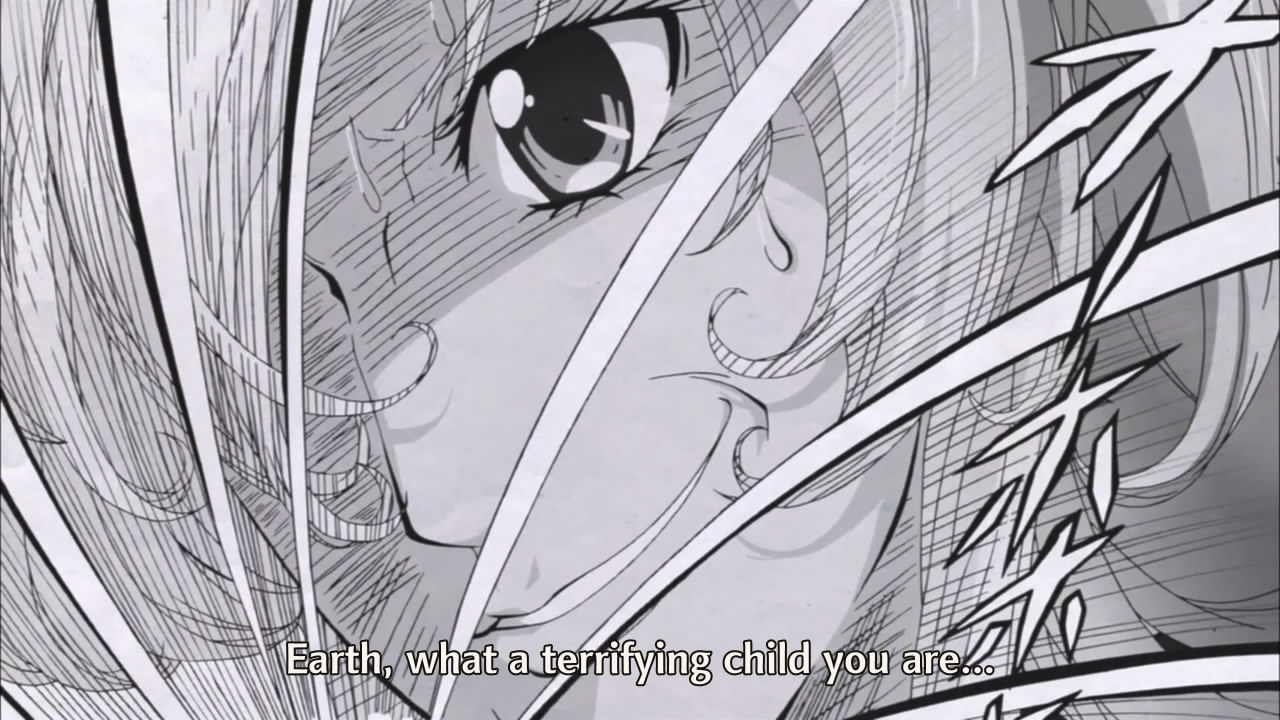
"Earth, what a terrifying child you are..." (7:41)
The Japanese line is "Chikyuu... Osoroshii ko!" (地球・・・恐ろしい子!). This is referencing a line said by Tsukikage Chigusa (月影千草) on page 57 of volume 1 of "Garasu no Kamen" (ガラスの仮面), "Glass Mask", a manga series written and illustrated by Miuchi Suzue (美内すずえ) and published starting from 1976.S1 Her original line goes, "Osoroshii ko!" (おそろしい子!) which translates to "What a terrifying child!". Image for reference:
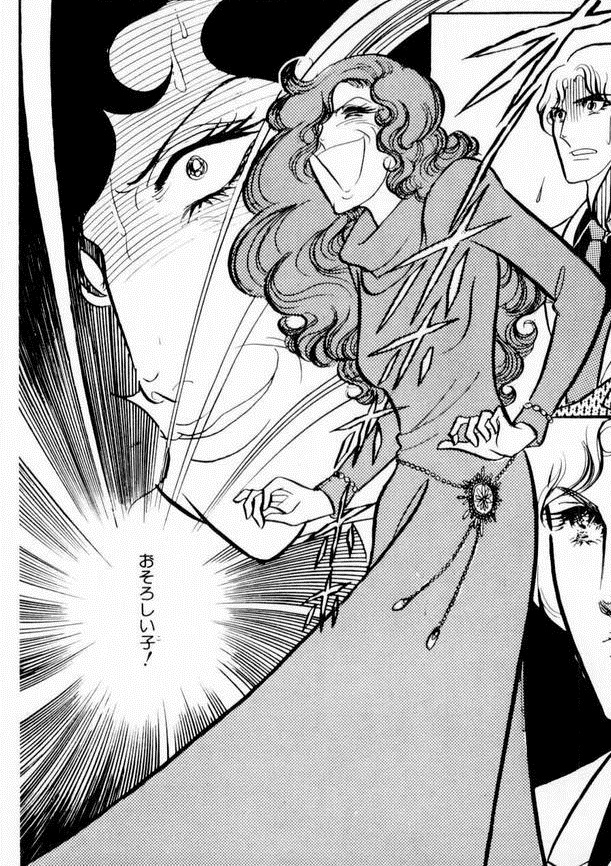
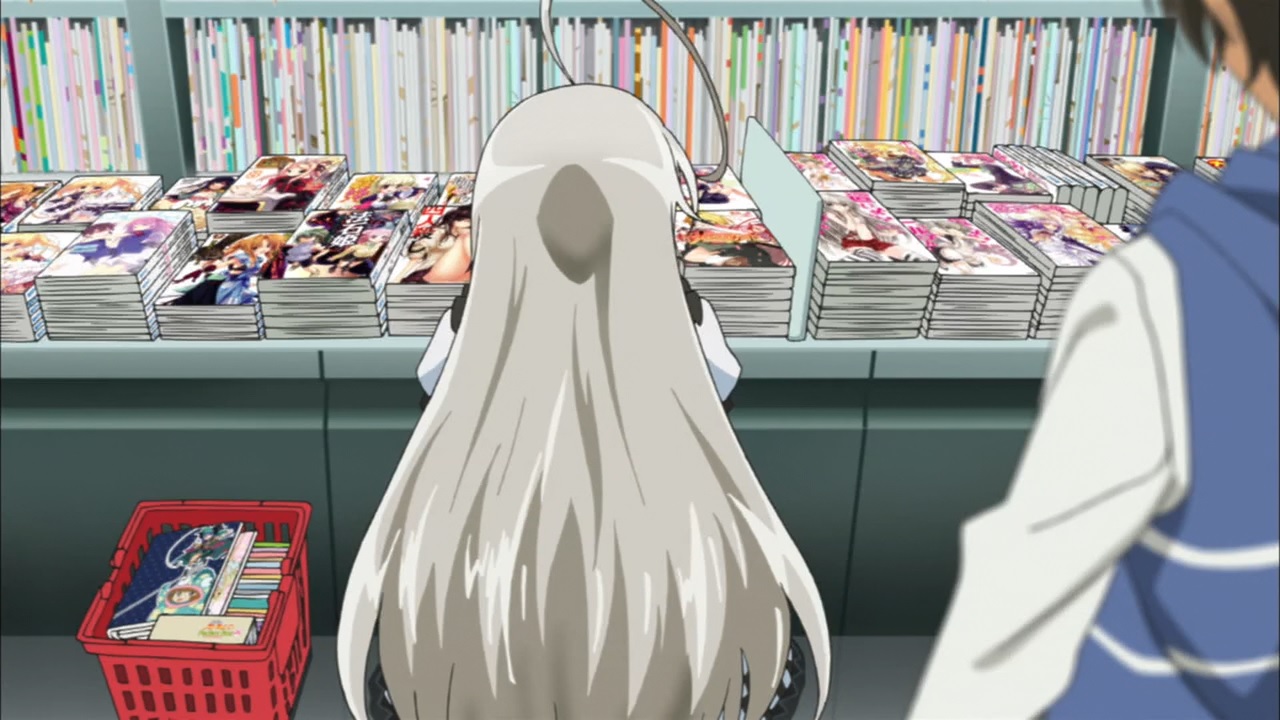
(7:45)
In the bottom left corner of the screen there is a book.
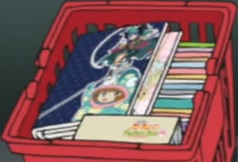
There are two references here:
* The cover art of this book is referencing the cover art for "Tatakae Houshi Shuzoku" (戦えっ奉仕種族), "Servantkind, Fight!", a "Call of Cthulhu" RPG replay book released by a doujinshi circle known as FGT in 1988. Image for reference:
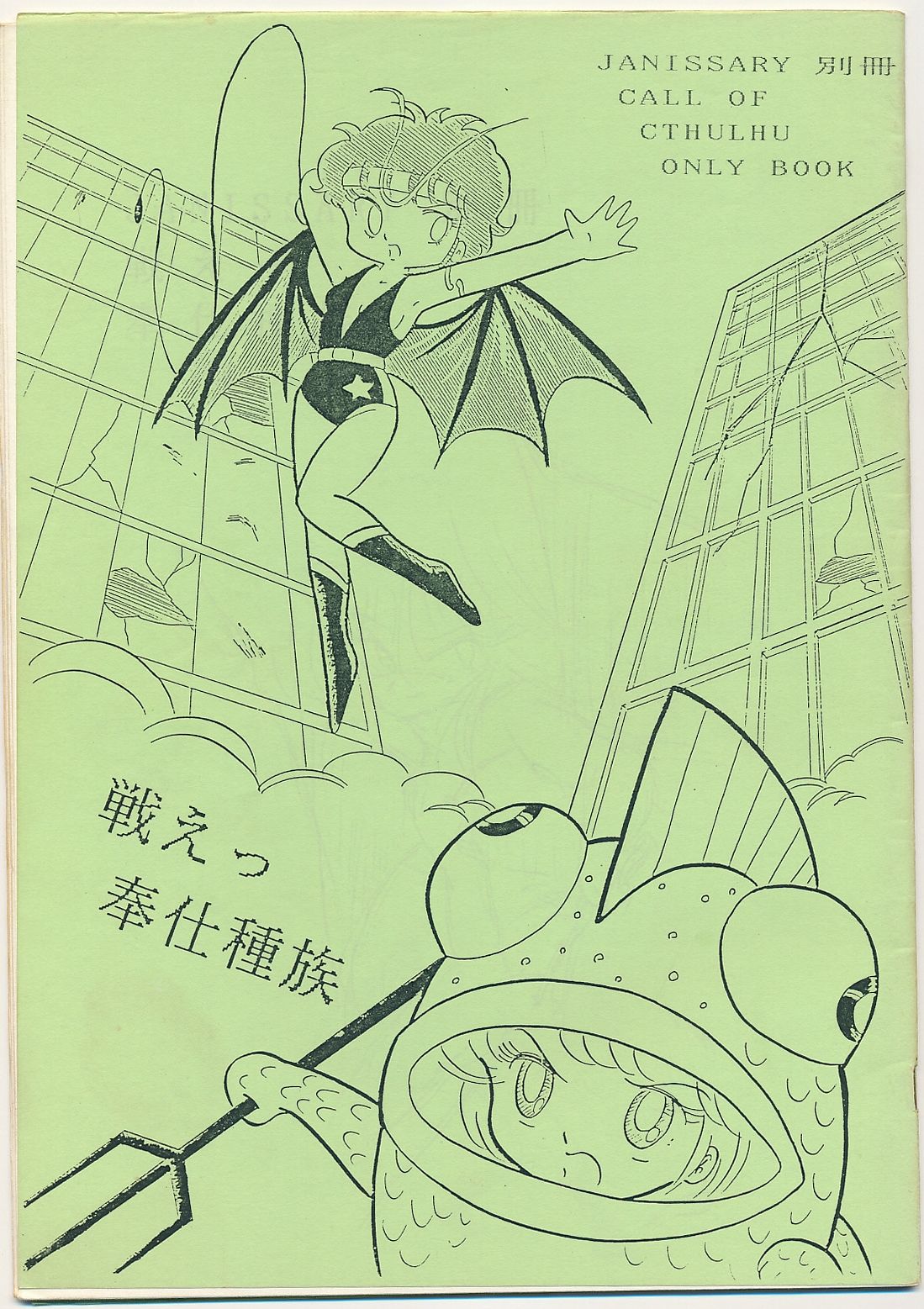
Source of image: http://moeponzu.com/blog-entry-1951.html
* The top character on the cover of this book is referencing Kokujou Ruruie (黒条流瑠家), also known as Magical Girl Ruruie (魔法少女ルルイエ), from "Shinra Banshou Choko Zekusu Fakutaa" (神羅万象チョコ ゼクスファクター), "Universal Creation Chocolate Sixth Factor", a brand of chocolate wafers produced by Bandai (バンダイ) from 2010 to 2011. Image for reference:

Source of image: https://shinrabansho.com/archive/zxf_charalist01.html
"Braw Bro!" (7:51)
Nyaruko yelp #2. Braw Bro (ブラウ・ブロ) is the name of a combat vehicle from "Mobile Suit Gundam" (機動戦士ガンダム), an anime series that aired from 1979 to 1980.S9

(8:27)
The red, blonde, and blue haired characters in the store are from "Miyama-san chi no Berutein" (深山さんちのベルテイン), "The Miyama Household's Berutein", another light novel written by Aisora Manta (逢空万太).S1 The characters from left to right are Miyama Kotarou (深山琥太郎), Mayauchi Riri (宮内理々), and Berutein (ベルテイン). On a side note, it is implied that both this light novel and "Haiyore! Nyaruko-san" take place in the same universe. Here is the cover of the first volume for reference:

Source of image: http://ga.sbcr.jp/novel/miyama/01.html

"Earth's pleasures are the best in the universe!" (8:36)
There are three references here:
* The Japanese line is "Chikyuu no goraku ha uchuu ichi!" (地球の娯楽は宇宙一!). This is referencing a line said, with variations, by Rudol von Stroheim (ルドル・フォン・シュトロハイム) in "Jojo no Kimyou na Bouken" (ジョジョの奇妙な冒険), "Jojo's Bizarre Adventure", a manga series written by Araki Hirohiko (荒木飛呂彦) and published starting from 1987. His line goes, "Nachisu no kagaku ha sekai ichi!" (ナチスの科学は世界一!), which translates to "The Nazi's science is the best in the world!". The pose she makes is also referencing Rudol.S1 Image for reference:
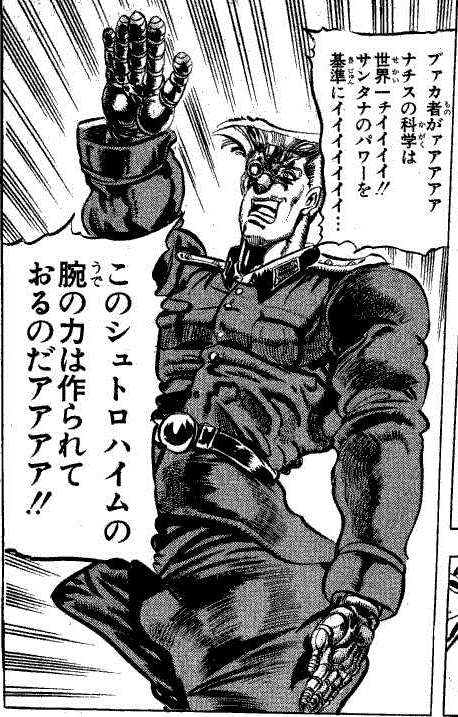
* Nyaruko's hairstyle and clothes are based on the cover art of "Nekuronomikon Ibun" (ネクロノミコン異聞), "Necronomicon Strange Tale", a light novel written by Toriyama Jin (鳥山仁) and published in 2011.S5 Image for reference:
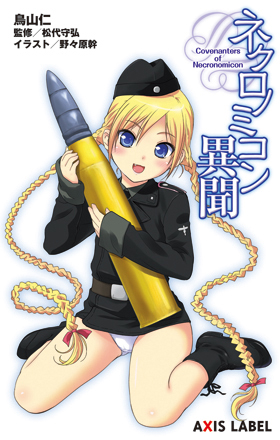
Source of image: https://www.ikaros.jp/sales/list.php?tidx=99&ID=2474
* The cannon in the background is based on the Schwerer Gustav and Dora, two massive German railway siege guns used during World War II.S5 Here's an image of a model of the Dora:
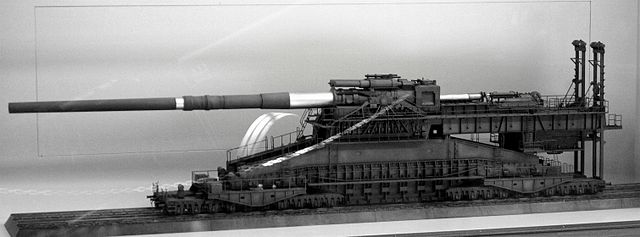
Source of image: https://en.wikipedia.org/wiki/File:GeschützDora2.JPG
"If it's not exposed, it's not a crime." (9:10)
The Japanese line is "Barenakya hanzai ja nai n desu yo" (バレなきゃ犯罪じゃないんですよ). This is referencing a line said by Kuujou Joutarou (空条承太郎) in chapter 236 in volume 25 of "Jojo no Kimyou na Bouken" (ジョジョの奇妙な冒険), "Jojo's Bizarre Adventure".S6 The original line goes, "Barenakyaa ikasama jaa nee n da ze" (バレなきゃあイカサマじゃあねえんだぜ), which translates to "If it's not exposed, it's not cheating". Image for reference:
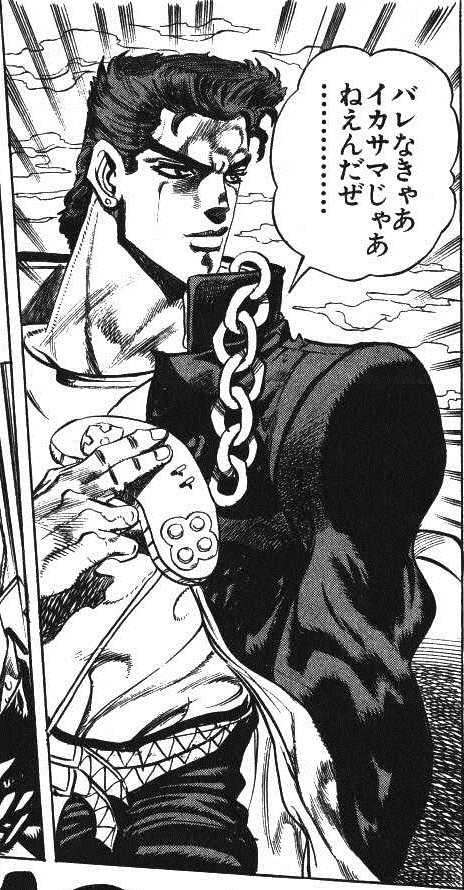
On a related note, this line itself is referencing a line said by Daniel J. D'Arby (ダニエル・J・ダービー) in chapter 213 in volume 23 of the series.S6 The original line goes, "Barenakereba ikasama to ha iwanai no da yo" (バレなければイカサマとはいわないのだよ), which translates to "If it's not exposed, it's not called cheating". Image for reference:

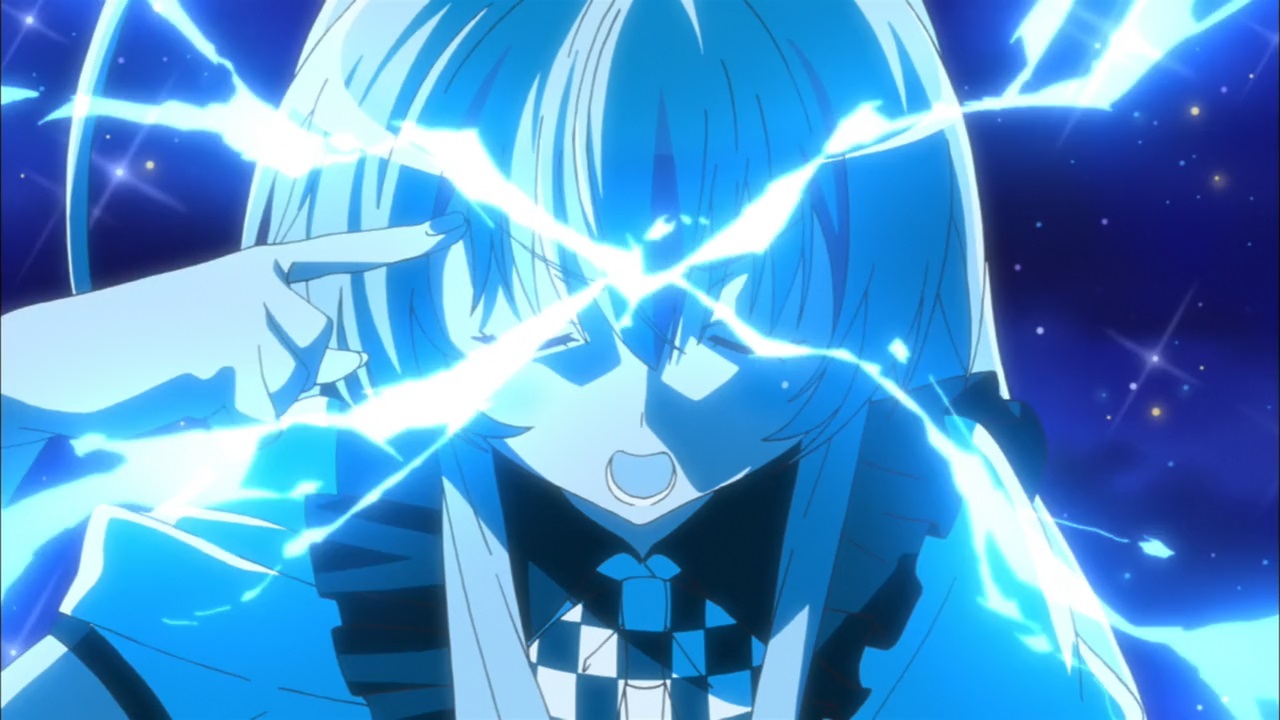
(10:07)
There are two references here:
* The line at this time goes as follows:
「護衛対象のデータを見たとき、ビビッ!と『私にも敵が見える!』的な効果音が鳴り響きました」This is referencing a line said by Char Aznable (シャア・アズナブル) in episode 42 of "Mobile Suit Gundam" (機動戦士ガンダム), an anime series that aired from 1979 to 1980. He also says this line in the third "Mobile Suit Gundam" movie that was released in 1982.S1 The original line goes as follows:
"Goei taishou no deeta wo mita toki, bibi! to 'watashi ni mo teki ga mieru!' teki na koukaon ga narihibikimashita"
"When I saw the data on the person to be guarded, an alarm went off in my mind like it was telling me 'I can also see the enemy!'"
見えるぞ!私にも敵が見える!Video for reference: https://youtube.com/watch?v=-0IPO1BJrNk
"Mieru zo! Watashi ni mo teki ga mieru!"
"I can see it! I can also see the enemy!"
* This is referencing Newtypes, a special breed of humans in "Mobile Suit Gundam" and other related "Gundam" series. Newtypes possess a heightened sense of awareness that allows them to detect hostility. When this sense activates, a lightning bolt effect flashes across the character's face as a visual cue. Image for reference:
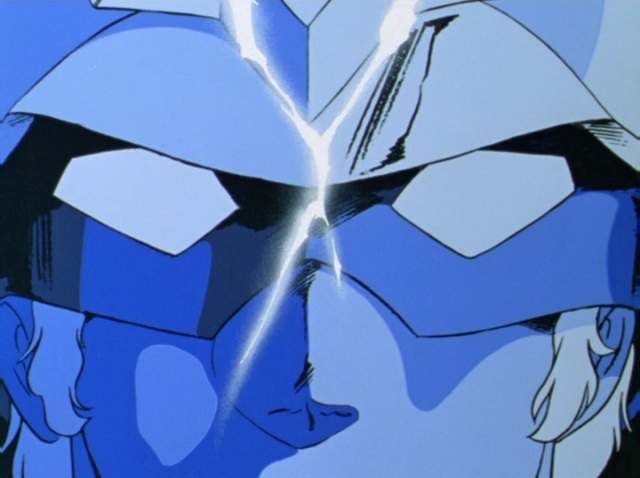
"I said it twice because it's important!" (11:14)
The Japanese line is "Daiji na koto nano de nikai iimashita!" (大事なことなので二回言いました!). This is referencing a popular Japanese TV commercial for the health product "Jokin ga Dekiru Tafudento" (除菌ができるタフデント), "Bacteria Eradicating Tough Dent", tablets used for cleaning dentures sold by the Kobayashi Pharmaceutical Company (小林製薬株式会社).S1 The original line goes, "Daiji na koto nano de nidai iimashita yo" (大事なことなので二度言いましたよ), which has the same meaning as above. Video reference: https://youtube.com/watch?v=2cHtNezvK3E
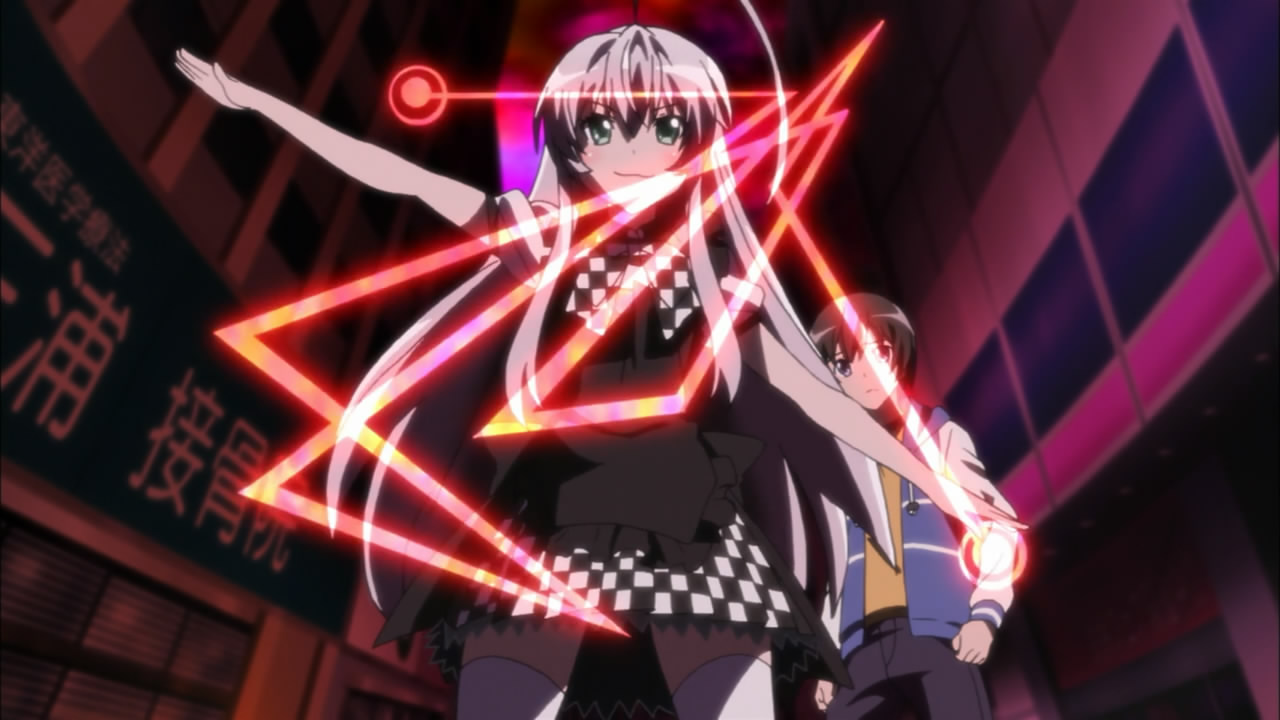
(11:28)
The symbol that appears here is based on the seal of Nyarlathotep on page 105 of "Necronomicon: The Wanderings of Alhazred", a real book written by Donald Tyson and published in 2004.S2 Image for reference:
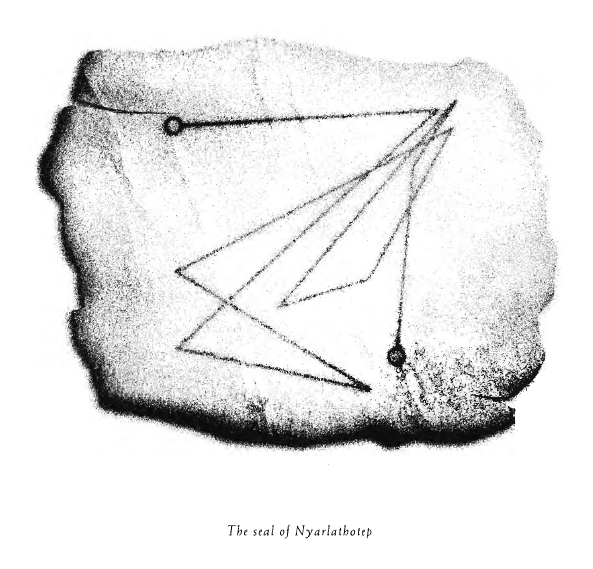
"Now let me demonstrate the basics of Space CQC" (11:29)
Space CQC is based on close quarters combat, abbreviated as CQC, a type of fighting that involves engaging the enemy at very short range. CQC is also a combat system from the game Metal Gear Solid, which is based on actual CQC.S1
"Let's start with the climax." (11:44)
The Japanese line is "Saisho kara kuraimakkusu desu!" (最初からクライマックスです!). This is referencing a line said by Momotarosu (モモタロス) in "Kamen Rider Den-O" (仮面ライダー電王), a Japanese TV show about a masked super hero that aired from 2007 to 2008.S1 His line, with variations, goes "Ore ha saisho kara kuraimakkusu da ze!" (俺は最初からクライマックスだぜ!), which translates to "From the start I'm at the climax!".
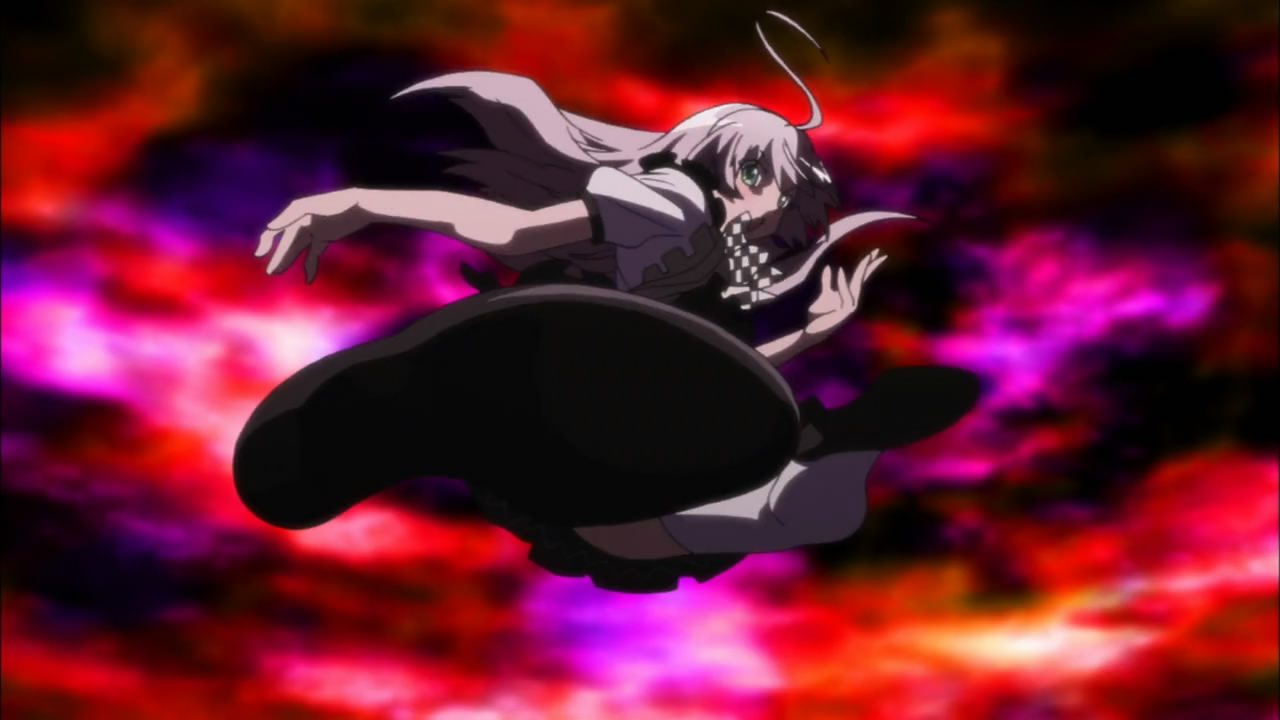
(11:49)
Nyaruko's kick is referencing Mighty Kick (マイティキック) used by Kamen Rider Kuuga in "Kamen Rider Kuuga" (仮面ライダークウガ), a Japanese TV show about a masked super hero that aired from 2000 to 2001.S1 Image for reference:
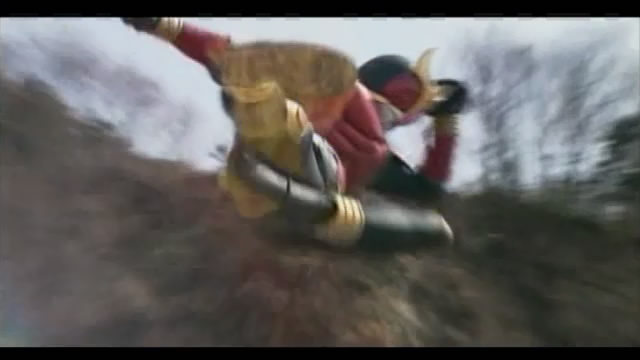
"You won't be able to defeat me by just acting tough with some half baked strength!" (12:00)
The Japanese line is "Ikigaru dake no hanpa na tsuyosa ja, watashi ni ha katemasen yo!" (粋がるだけの半端な強さじゃ、私には勝てませんよ!). This is referencing a line said by Kintarosu (キンタロス) in episode 9 of "Kamen Rider Den-O" (仮面ライダー電王).S1 His line goes, "Ikigaru dake no tsuyosa de ha ore ni katarehen" (いきがるだけの強さでは俺に勝たれへん), which translates to "You won't be able to defeat me by just acting tough".

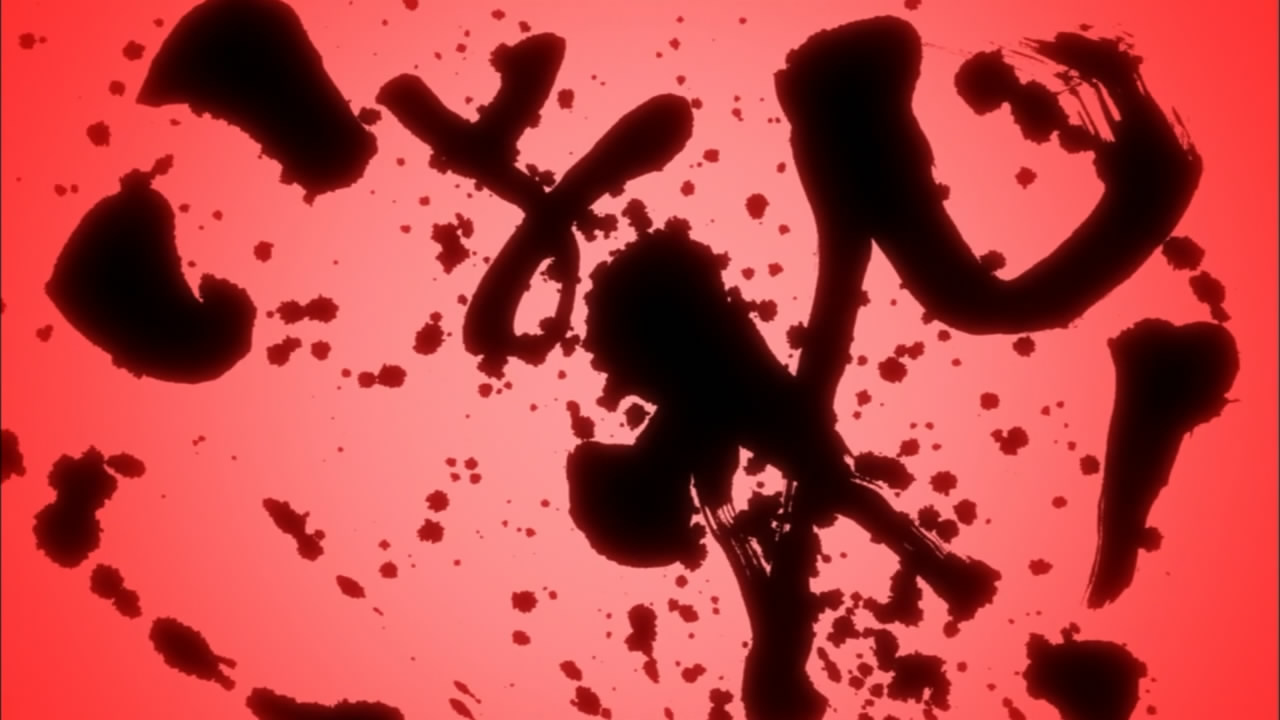
(12:06)
The text that appears reads "Haiyore!" (這いよれ!), "Crawl!", from the title. The text is referencing those from "Kamen Rider Hibiki" (仮面ライダー響鬼), a Japanese TV show about a masked super hero that aired from 2005 to 2006.S11 Images for reference:
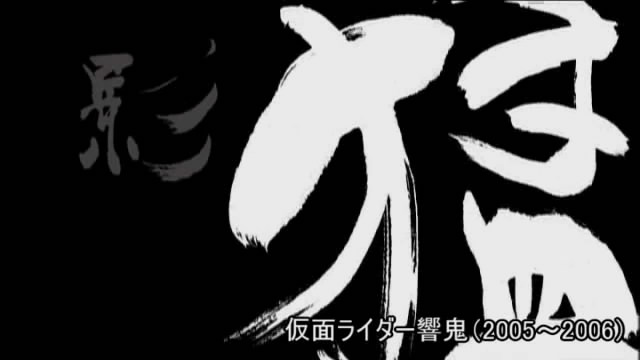
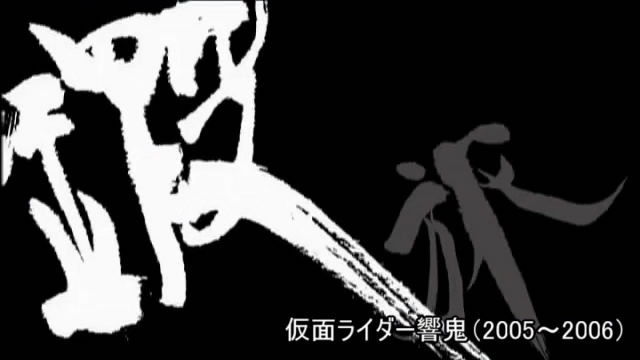
"That's right! I love you!" (12:39)
The Japanese line is "Yappari sou, anata ga daisuki desu" (やっぱりそう、あなたが大好きです). This is a line in the lyrics to "Suki, Suki, Daisuki" (好き、好き、大好き), "I Love Love Love You", a song sung by Asumi Kana (阿澄佳奈) and released in 2009.S5 This song is the ending theme song to "Haiyoru! NyaruAni" (這いよる! ニャルアニ), an anime series based on "Haiyore! Nyaruko-san" that aired from 2009 to 2010.
"Gau!" (12:47)
Nyaruko yelp #3. Gaw (ガウ) is the name of a combat vehicle from "Mobile Suit Gundam" (機動戦士ガンダム).S9
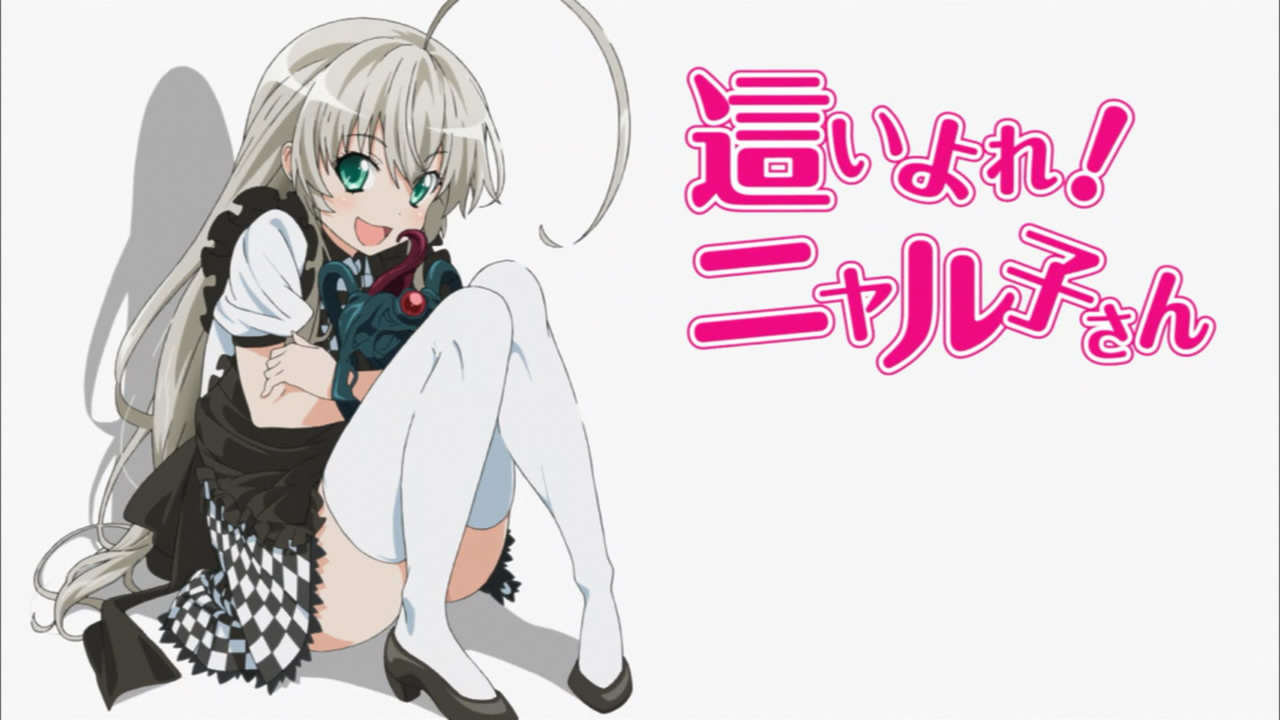
(13:09)
There are two references here:
* The appearance of the creature Nyaruko is holding is based on the Bloody Tongue, one of the many forms Nyarlathotep can assume in the Cthulhu Mythos. In the 5th edition rule book for the "Call of Cthulhu" RPG, it is described as follows:
"The Bloody Tongue is an enormous monster with clawed appendages and a single long blood-red tentacle in place of a face. This tentacle stretches forward when the Thing howls at the moon."* The depiction here of the Bloody Tongue is based on a depiction of the Bloody Tongue drawn by Nottsuo, which was used as the cover art of "CTHULHU 2010", a book containing supplemental material for the "Call of Cthulhu" RPG published by enterbrain (エンターブレイン) in 2010.S8 Image for reference:
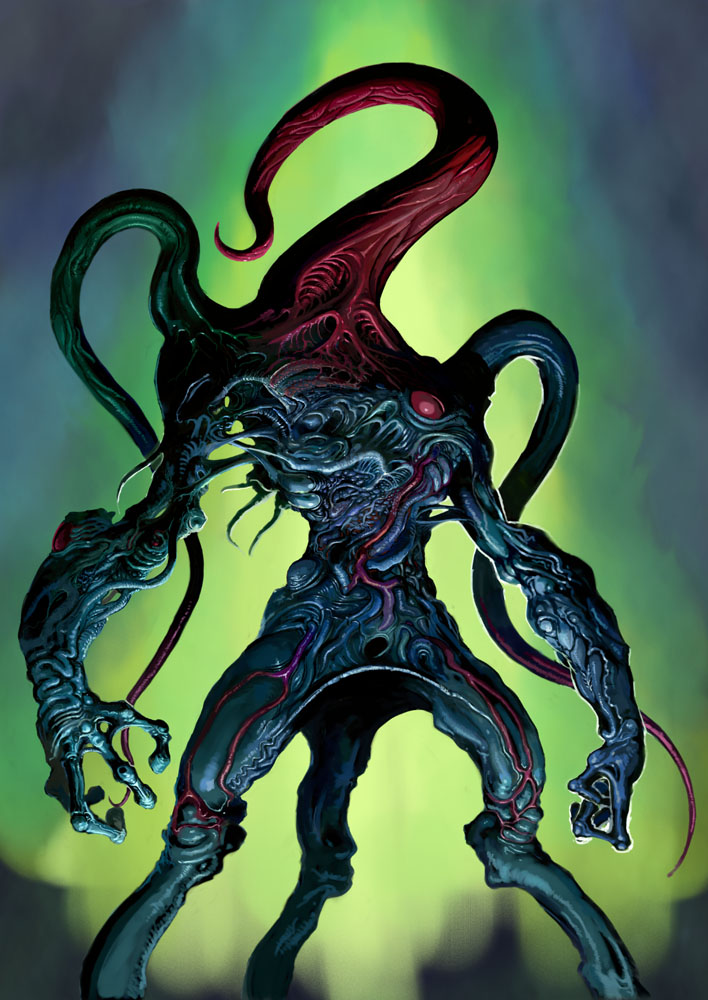
Source of image: https://www.pixiv.net/artworks/8756265
"That is definitely absolutely true." (13:31)
The Japanese line is "Sore ha zettai ni zettai desu" (それは絶対に絶対です). This is referencing a line often said, with some variations, by Cecilia Raynne Adlehyde (セシリア・レイン・アーデルハイド) in "WILD ARMS" (ワイルドアームズ), a game released by Media.Vision (メディア・ビジョン) in 1996.S4 Her line is, "Sore ha, zettai ni zettai desu!" (それは、ぜったいにぜったいですッ!), which translates to "That is definitely absolutely true!". Image for reference:
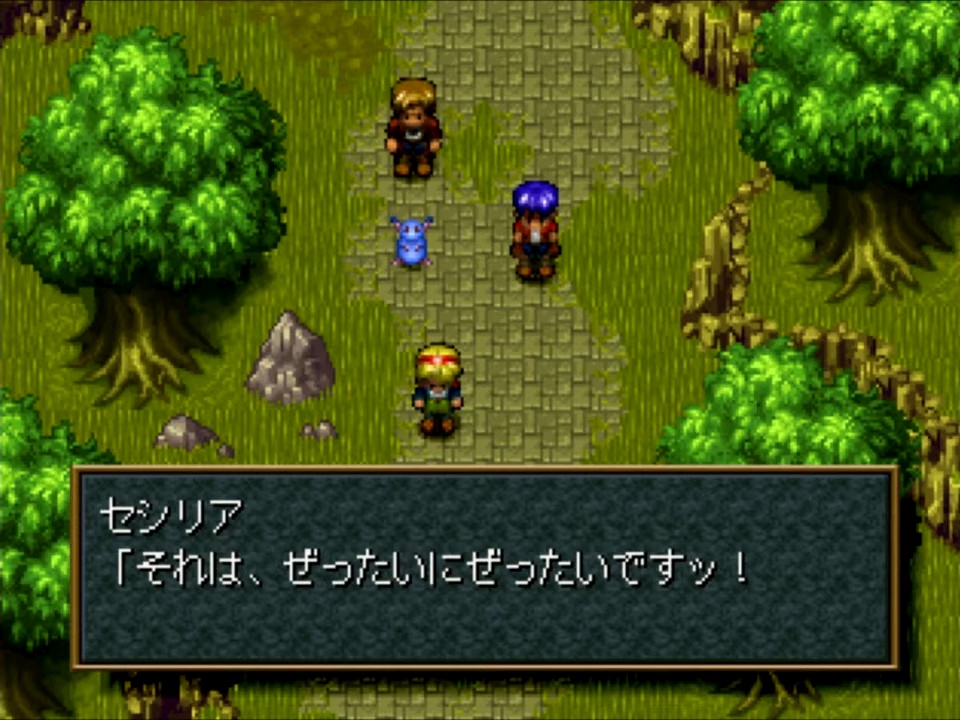
Source of image: https://www.youtube.com/watch?v=rXm7G5OymKA
On a related note, there is a monster that appears in "Wild Arms" called "Haiyoru Konton" (這いよる混沌), "Crawling Chaos", which is one of the names that Nyarlathotep is known by.S4 Image for reference:
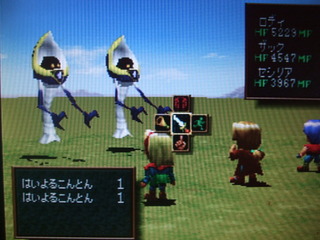
Source of image: http://blog.goo.ne.jp/grflitter/e/531188ea849a100b603acc2f244c2a9b
(14:01)
The line at this time goes as follows:
「星から星に泣く人の、涙背負って邪神の始末。いつもニコニコ真尋さんの隣に這いよる混沌、ニャルラトホテプ!お呼びとあらば即参上!」This is referencing the line at the start of the opening to "Ginga Senpuu Buraigaa" (銀河旋風ブライガー), "Galaxy Cyclone Braiger", an anime series that aired from 1981 to 1982.S1 The original line goes as follows:
"Hoshi kara hoshi ni naku hito no, namida seotte jashin no shimatsu. Itsumo nikoniko Mahirosan no tonari ni haiyoru konton, Nyaruratohotepu! Oyobi to areba soku sanjou!"
"Traveling amidst the stars with the tears of many on my back and eliminating evil gods... I am the chaos, always crawling up to Mahiro with a smile, Nyarlathotep. Call my name, and I will appear."
「夜空の星が輝く陰で、悪(ワル)の笑いがこだまする。星から星に泣く人の、涙背負って宇宙の始末。銀河旋風ブライガー、お呼びとあらば即参上!」
"Yozora no hoshi ga kagayaku kage de, waru no warai ga kodama suru. Hoshi kara hoshi ni naku hito no, namida seotte uchuu no shimatsu. Ginga Senpuu Buraigaa, oyobi to areba soku sanjou!"
"Beneath the night sky, evil laughter echos in the shadows of the shining stars. Traveling amidst the stars with the tears of many on my back and cleaning up the universe. Galaxy Cyclone Braiger, call my name and I will appear!"
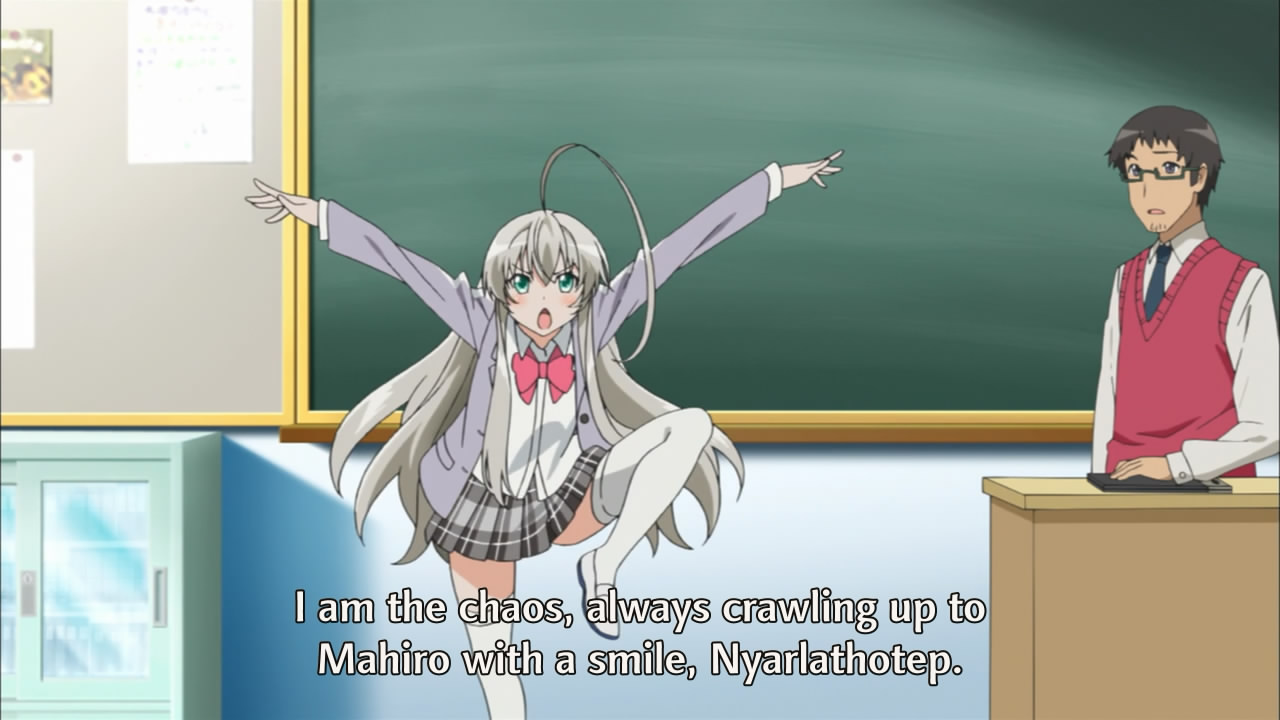
(14:11)
The pose at this time is referencing "araburu taka no poozu" (荒ぶる鷹のポーズ), "pose of the wild hawk", done by Kamiyama Venus (神山ビーナス) in "Kamisama Kazoku" (神様家族), "God Family", a light novel series written by Kuwashima Yoshikazu (桑島由一) and published from 2003 to 2008.S1 This pose also appears in episode 10 of the anime adaptation of this light novel series that aired in 2006. Image for reference:
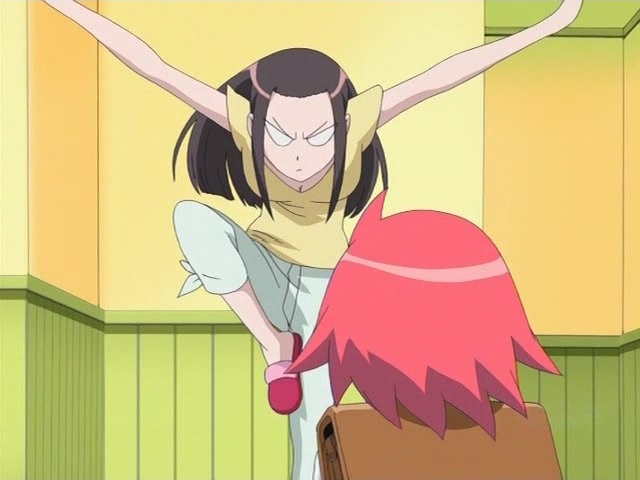
"Gaza-C!" (14:17)
Nyaruko yelp #4. Gaza-C (ガザC) is the name of a combat vehicle from "Mobile Suit Zeta Gundam" (機動戦士Ζガンダム).S9

(14:18)
The text on the blackboard was written by Nyaruko's voice actor, Asumi Kana (阿澄佳奈).S2 A tweet posted by the official "Haiyore! Nyaruko-san" Twitter account goes as follows:
「黒板の字、阿澄さんの直筆って分かりました?」
"Did you know the writing on the blackboard is Asumi's handwriting?"
(16:51)
The line at this time goes as follows:
「クロックアップしたニャルラトホテプ星人は常識をはるかに超えるスピードが可能なのですよ」"Kurokku appu" (クロックアップ), "Clock up", is a special ability used by Kamen Riders in "Kamen Rider Kabuto" (仮面ライダーカブト), a Japanese TV show about a masked super hero that aired from 2006 to 2007. Clock Up allows the user to move at extremely high speeds.S1
"Kurokku appu shita nyaruratohotepuseijin ha joushiki wo haruka ni koeru supiido ga kanou nano desu yo."
"A clocked up Nyarlathotepian is capable of speeds that far exceed those of common sense."
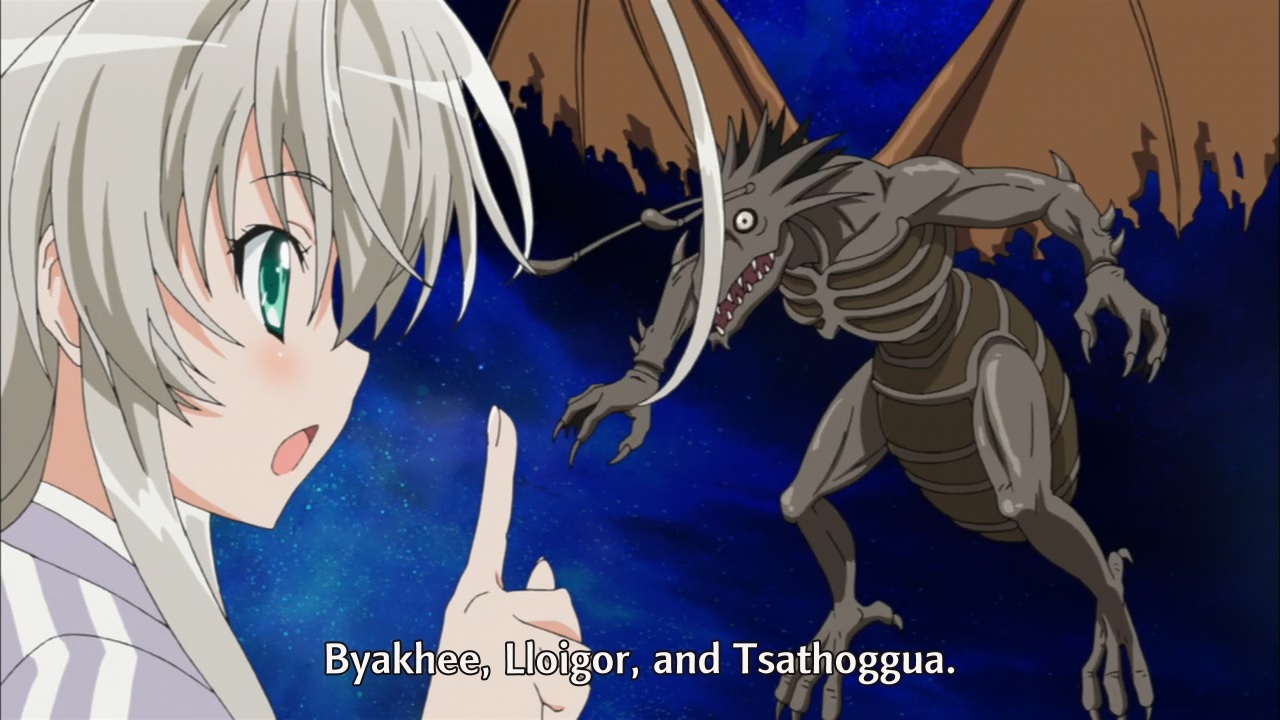
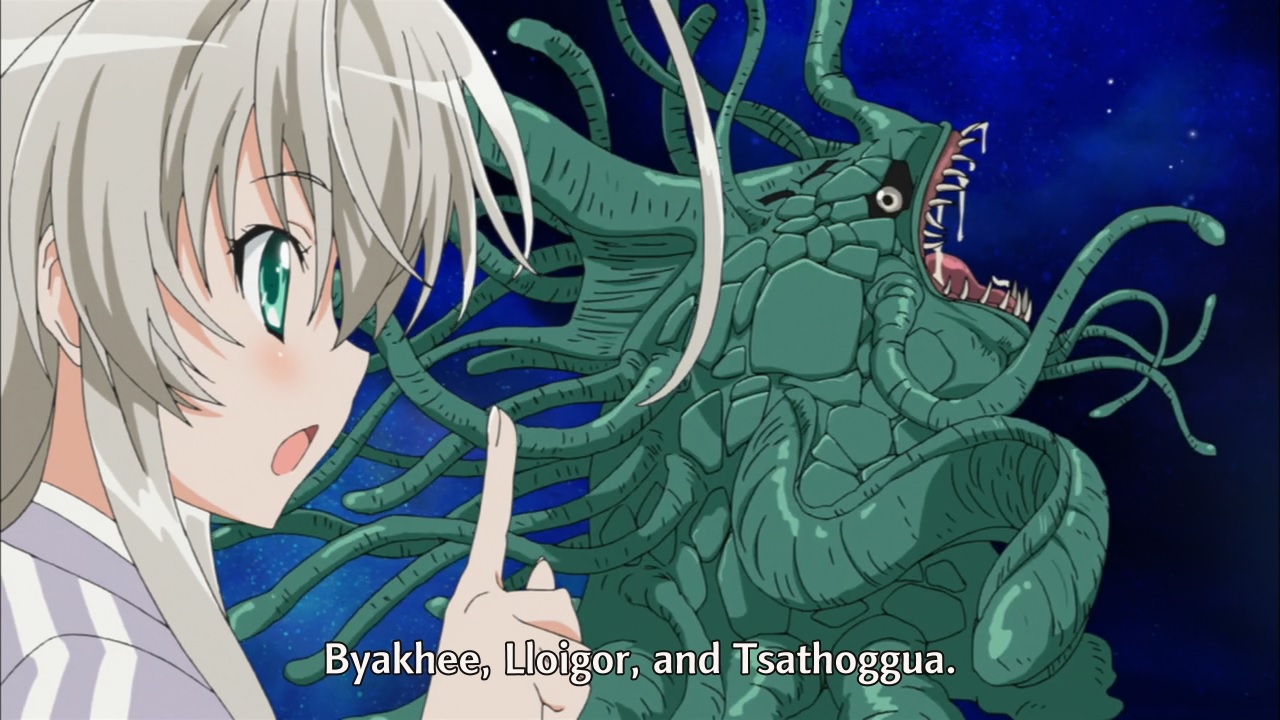
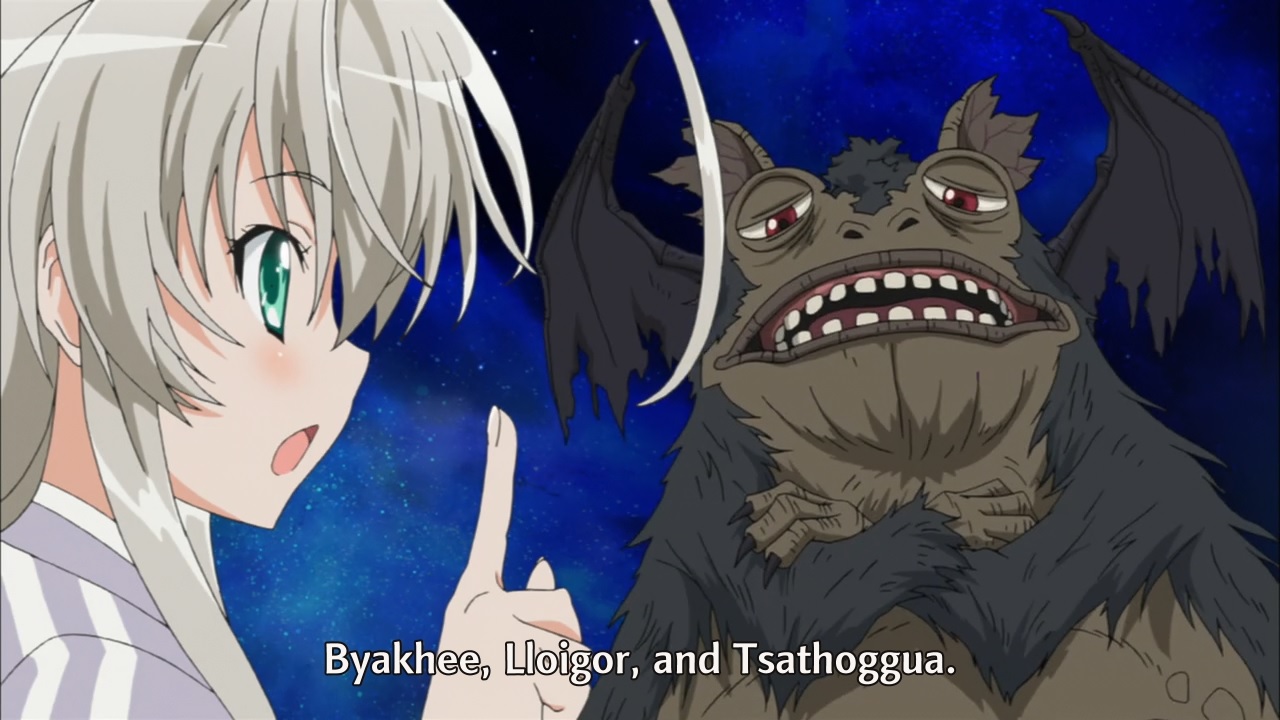
"Byakhee, Lloigor, and Tsathoggua." (17:53)
This line references creatures in the Cthulhu Mythos.
* Byakhee is a species of creature in the Mythos. In "The Festival", a short story written by H. P. Lovecraft and published in 1925, it is described as follows:
"They were not altogether crows, nor moles, nor buzzards, nor ants, nor vampire bats, nor decomposed human beings; but something I cannot and must not recall. They flopped limply along, half with their webbed feet and half with their membraneous wings..."* Lloigor is also a species of creature in the Mythos. In "The Return of the Lloigor", a short story written by Colin Wilson and first published in 1969, it is described as follows:
"In human terms, they were formless and invisible."The "monster on the tablet" mentioned above is a depiction of the Lloigor, and is described as follows:
"Like wind or electricity. You have to understand they were forces rather than beings. They weren't even clear separate identities, as we are."
"These latter, he said, were definitely aliens on our earth, and the chief among them was called Ghatanothoa, the dark one. They sometimes took forms, such as the monster on the tablet—who was a representation of Ghatanothoa—but existed as "vortices" of power in their natural state."
"The inscription was in curved characters, not unlike Pitman's shorthand; the face in the midst of them could have been a devil mask, or a snake god, or a sea monster."The depiction in the above scene appears to be based on a depiction of Lloigor on the cover of the Japanese publication of "The Return of the Lloigor", which was published in 1977 and titled "Roigaa no Fukkatsu" (ロイガーの復活), which translates to "The Resurrection of the Lloigor". Cover image for reference:
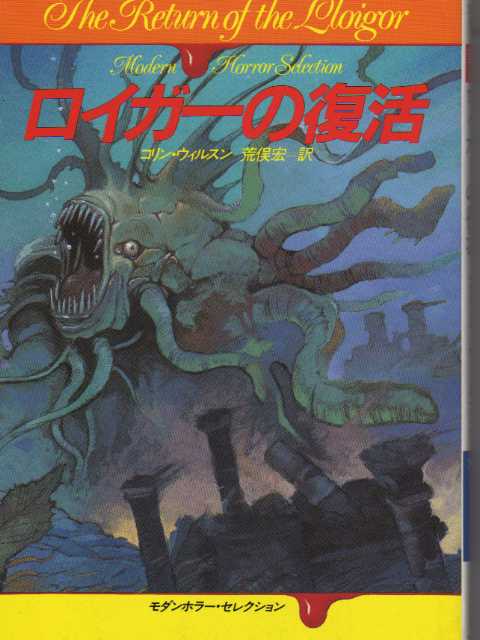
Source of image: http://bookshelf.co.jp/product_info.php/products_id/58484
* Tsathoggua is a creature classified as a Great Old One in the Cthulhu Mythos. In "The Tale of Satampra Zeiros", a short story written by Clark Ashton Smith and published in 1931, Tsathoggua is described as follows:
"He was very squat and pot-bellied, his head was more like that of a monstrous toad than a deity, and his whole body was covered with an imitation of short fur, giving somehow a vague suggestion of both the bat and the sloth. His sleepy lids were half-lowered over his globular eyes; and the tip of a queer tongue issued from his fat mouth."
"Dijeh!" (18:00)
Nyaruko yelp #5. Dijeh (ディジェ) is the name of a combat vehicle from "Mobile Suit Zeta Gundam" (機動戦士Ζガンダム).S9

(18:06)
The teacher's appearance resembles that of her voice actor, Matsuki Miyu (松来未祐).S1 Image for reference:
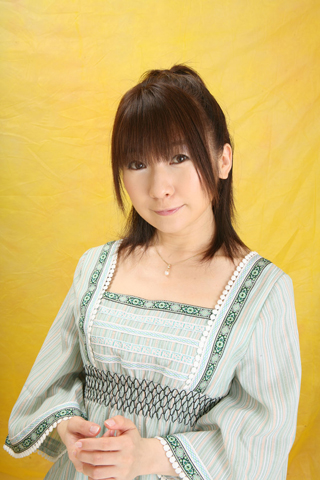
Source of image: http://www.animate.tv/news/img.php?id=1291686316&p;=1&n;=2
"I'm so embarassed I think I'll get pregnant." (18:28)
The Japanese line is "Hazukashikute akachan dekichaisou desu no" (恥ずかしくて赤ちゃん出来ちゃいそうですの). This is referencing a line often said by Shizukuishi (雫石), one of the main characters of "Iinari! Aibureeshon" (いいなり! あいぶれーしょん), a manga series written by Nakajima Chizuna (中嶋ちずな) and published from 2006 to 2010.S5 Her line typically goes, "Hazukashikute... akachan dekichaisou desu..." (恥ずかしくて・・・赤ちゃんできちゃいそうです・・・), which has the same meaning as above. Image for reference:

"Gyan!" (18:33)
Nyaruko yelp #6. Gyan (ギャン) is the name of a combat vehicle from "Mobile Suit Gundam" (機動戦士ガンダム).S9
(18:41)
The line at this time goes as follows:
「病的かつ冒涜的な禍々しい混沌とした痛みに襲われているので、保健室に行ってきてもいいですか?」This is referencing a line from "The Unnamable", a short story written by H. P. Lovecraft and first published in 1925.S7 The story was translated into Japanese with the title "Meijou Shigatai Mono" (名状しがたいもの) by Ootaki Keisuke (大瀧啓裕) and published in "The Complete Works of Lovecraft 6" (ラヴクラフト全集6) in 1989. The original line goes as follows:
"Byouteki katsu boutoku teki na magamagashii konton to shita itami ni osowareteiru no de, hokenshitsu ni itte kite mo ii desu ka?"
"I'm suffering from malign chaotic pain, itself a morbid blasphemy, so could I please go to the infirmary?"
「それ自体が自然にそむく病的かつ冒涜的な、凶まがしい混沌とした奇形の幽霊のごとき」 (大瀧啓裕訳)
"... sore jitai ga shizen ni somuku byouteki katsu boutoku teki na, magamagashii konton to shita kikei no yuurei no gotoki..." (Ootaki Keisuke translation)
"... as the spectre of a malign, chaotic perversion, itself a morbid blasphemy against Nature..." (original text)
"Maybe I'll let the capsule monster handle this one." (19:12)
Nyaruko uses the term "kapuseru kaijuu" (カプセル怪獣), which translates to "capsule monster". This is the term used to refer to capsule contained monsters used by Ultra Seven in "Ultra Seven" (ウルトラセブン), a Japanese TV show about a super hero from outer space that aired from 1967 to 1968.S3

"Shanta! I choose you!" (19:27)
The Japanese line is "Shanta-kun! Kimi ni kimeta!" (シャンタッ君!君に決めた!). This is referencing the "Pokemon" series. The title of the first episode of the anime adaptation of "Pokemon" is "Pokemon! Kimi ni kimeta!" (ポケモン! きみにきめた!), which translates to "Pokemon! I choose you!". In general, "Kimi ni kimeta" (きみにきめた), "I choose you!", is a phrase that is often used in the series. Additionally, Nyaruko is holding what distinctly resembles a Pokeball, a device used to capture Pokemon. Nyaruko's pose is also referencing a pose used in the series. Image for reference:

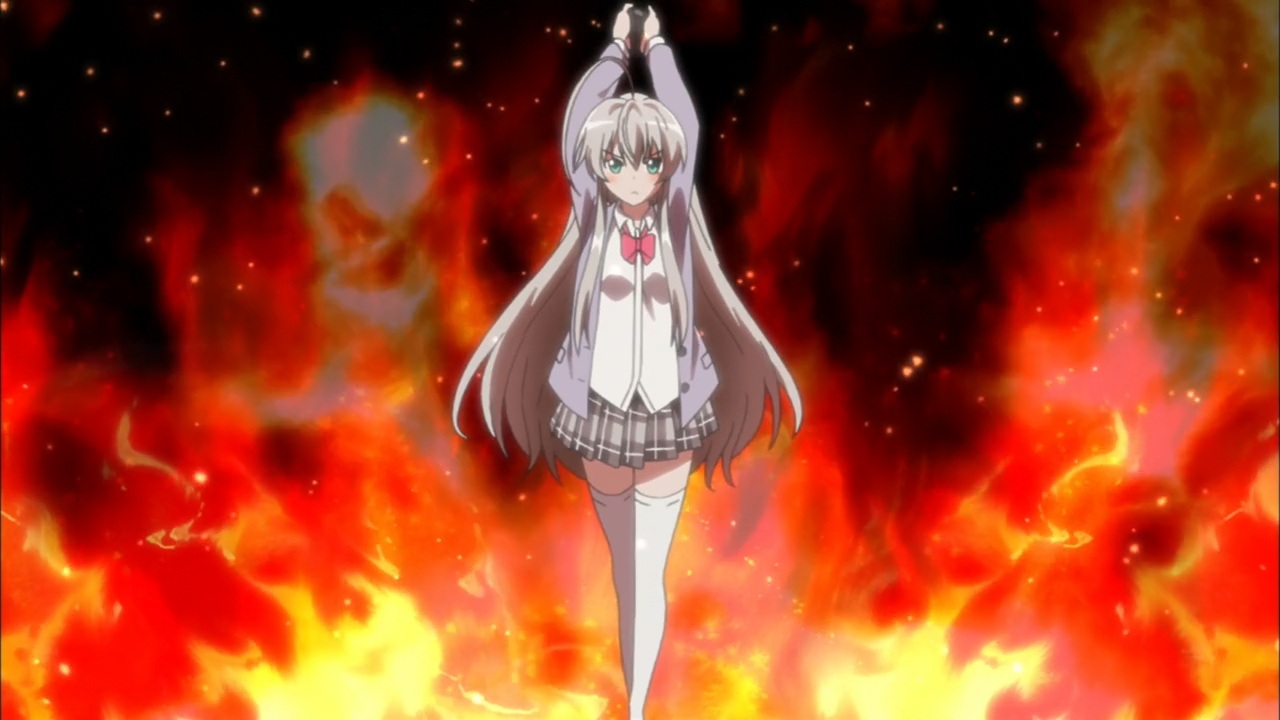
(19:30)
This scene is referencing Hoshi Hyuuma (星飛雄馬) from "Kyojin no Hoshi" (巨人の星), "Star of the Giants", a manga series written by Kajiwara Ikki (梶原一騎) and published from 1966 to 1971. Nyaruko's pitching form is referencing that of Hoshi when he does his special technique, "Dai Riigu Booru Ichigou" (大リーグボール1号), "Major League Ball #1".S1 Images for reference:

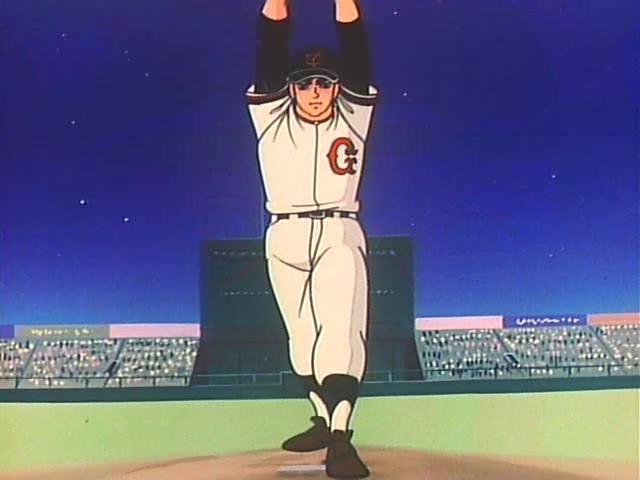
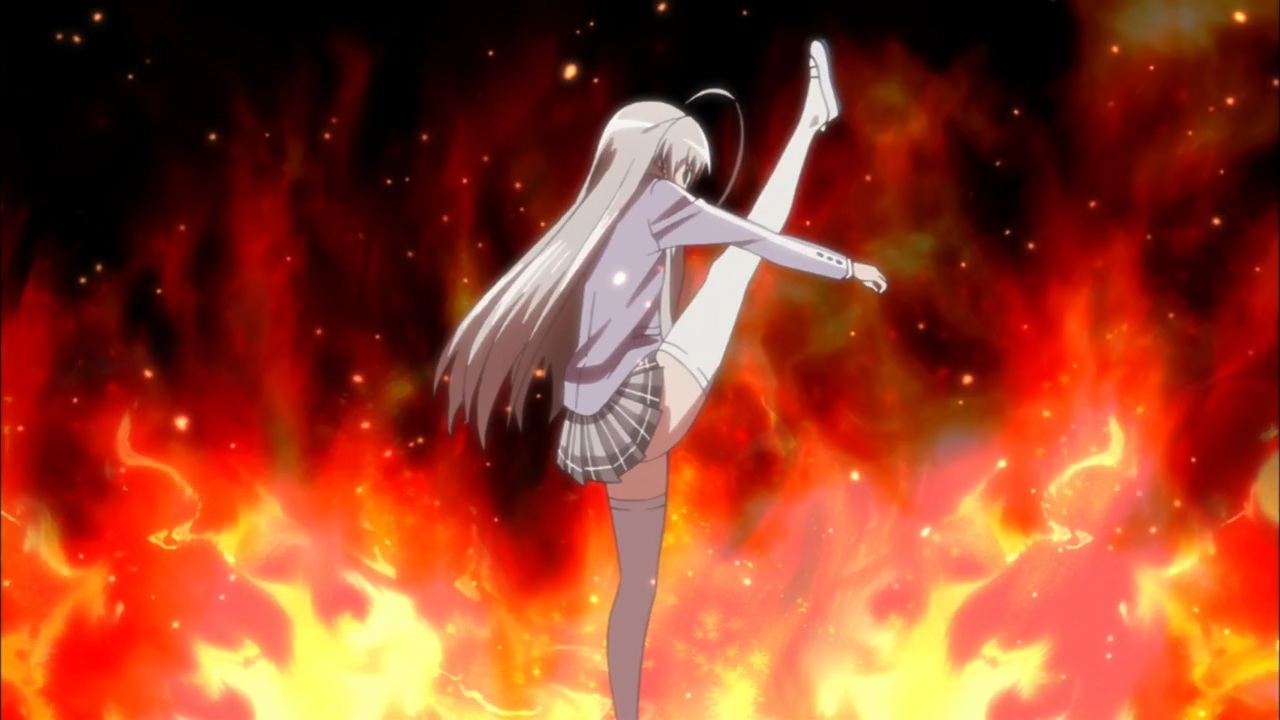
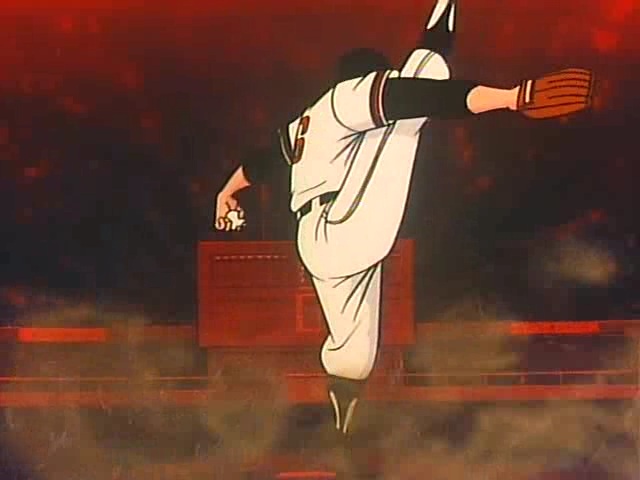
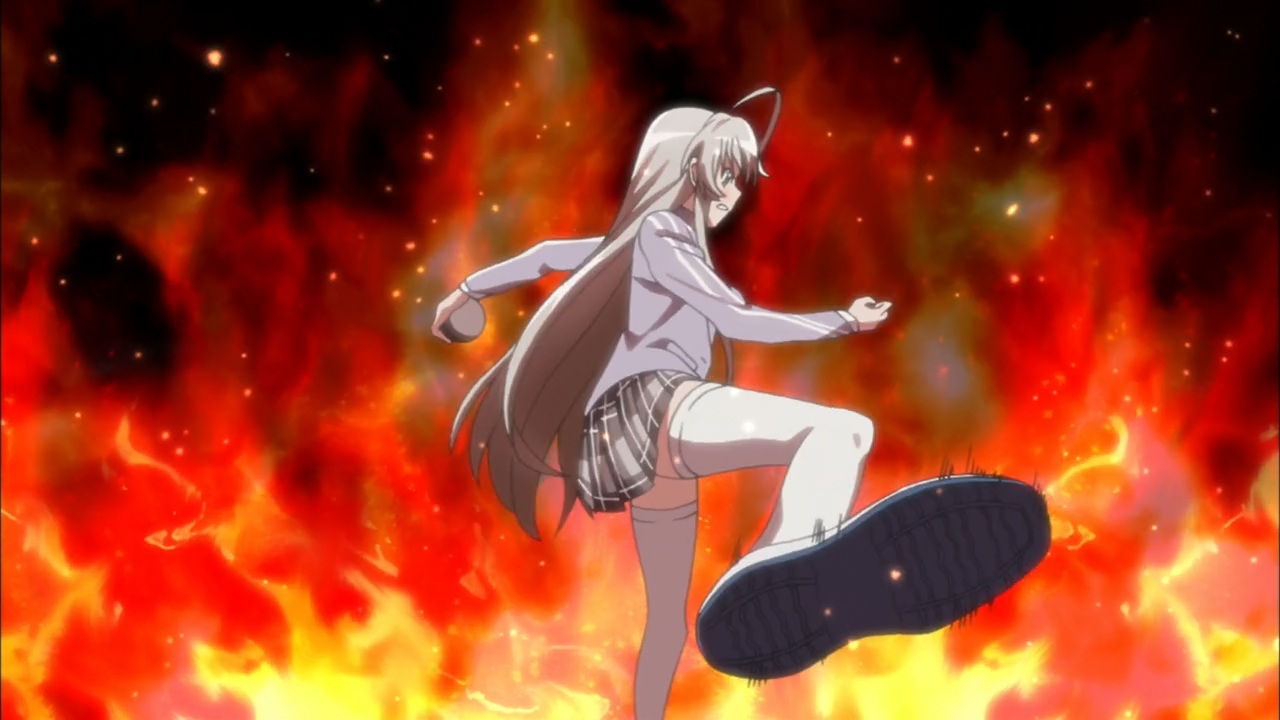
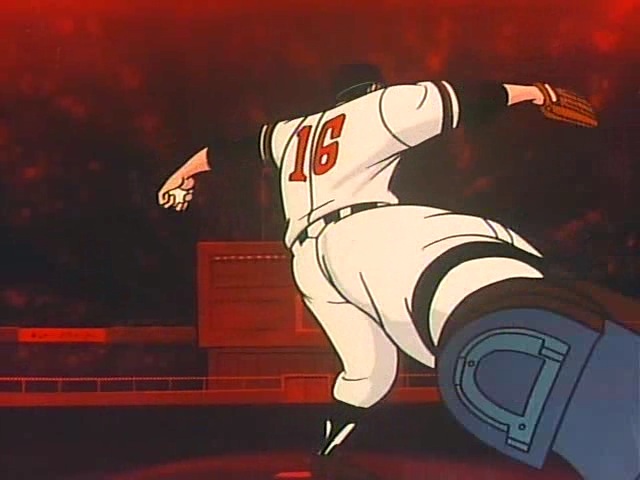
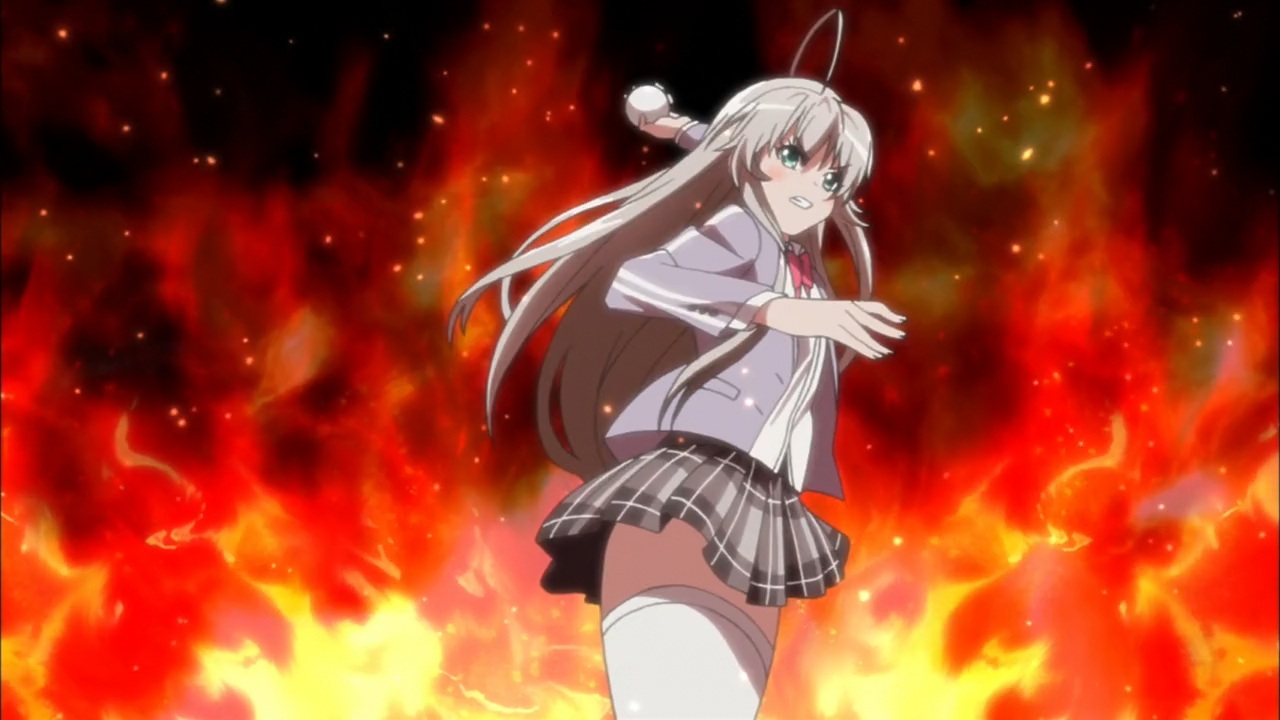
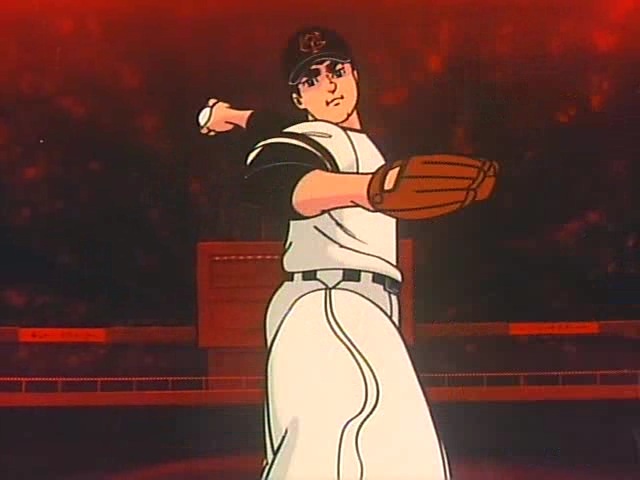
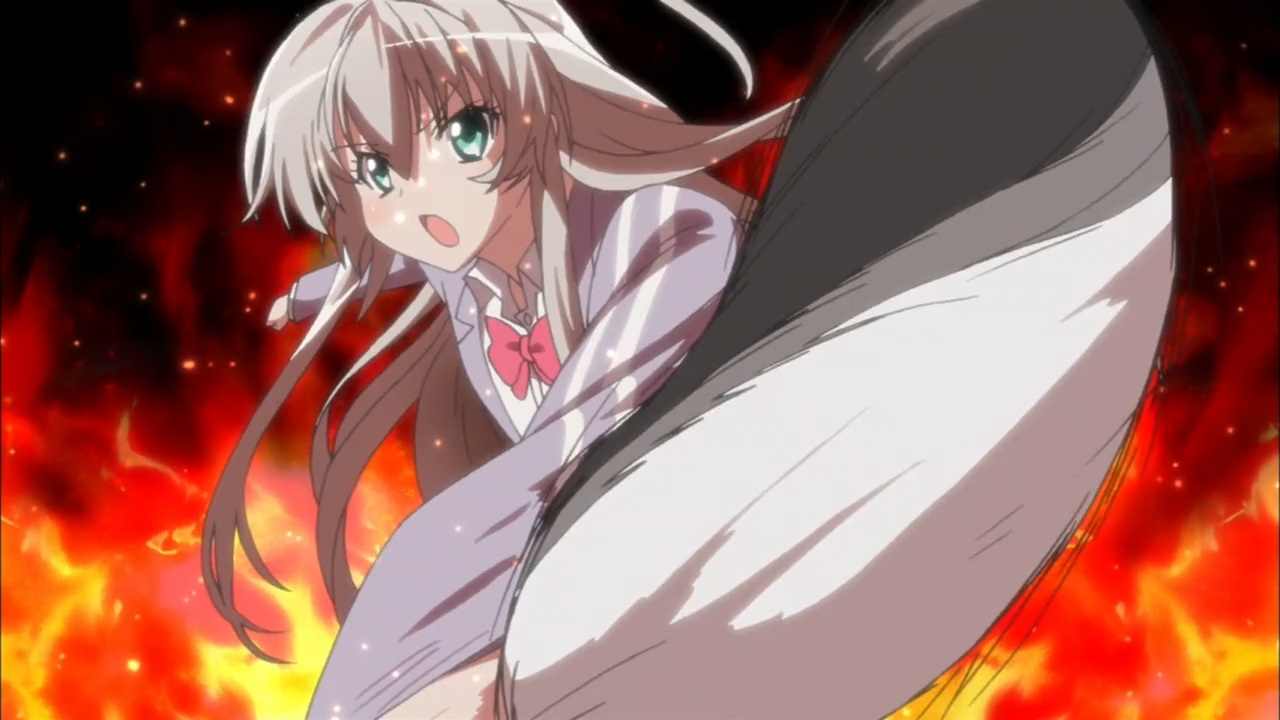
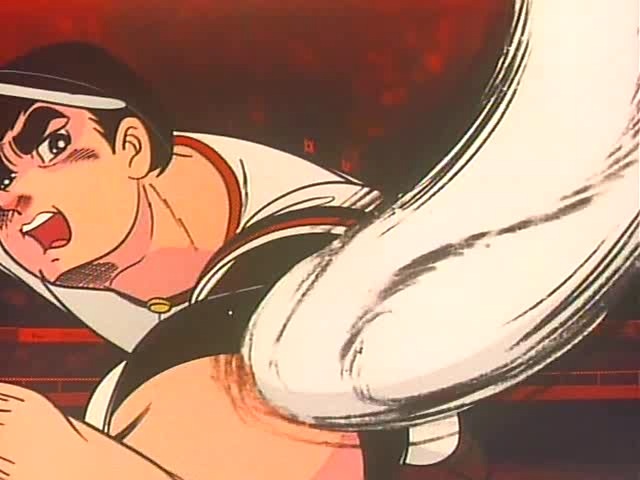

"One of my pets, Shantakkun, the Shantak-bird." (19:36)
Shantak is a species of creature in the Cthulhu Mythos. In "The Dream-Quest of Unknown Kadath", a story written by H. P. Lovecraft and published in 1943, Shantaks are described as follows:
"They were not any birds or bats known elsewhere on earth or in dreamland, for they were larger than elephants and had heads like a horse's. ... the shantak-bird has scales instead of feathers, and those scales are very slippery."Additionally, in this story, Shantak are shown to follow the orders of Nyarlathotep.
"Shanta's got 99 losses and one draw against Nightgaunts." (20:09)
This is referencing how in "The Dream-Quest of Unknown Kadath", a story written by H. P. Lovecraft and published in 1943, it is stated that Shantaks fear Nightgaunts.
"It's time for my deadly Space CQC Part 2 Dash!" (20:29)
The Japanese line is "Hissatsu! Watashi no Uchuu Shii Kyuu Shii Paato Tsuu Dasshu!" (必殺!私の宇宙CQCパート2ダッシュ!). This is referencing a line said by Momotarosu (モモタロス) in episode 4 of "Kamen Rider Den-O" (仮面ライダー電王). His line goes, "Ore no Hissatsu Waza Paato Tsuu Dasshu!" (俺の必殺技パート2ダッシュ!), which translates to "My Certain Kill Technique Part 2 Dash!".S1
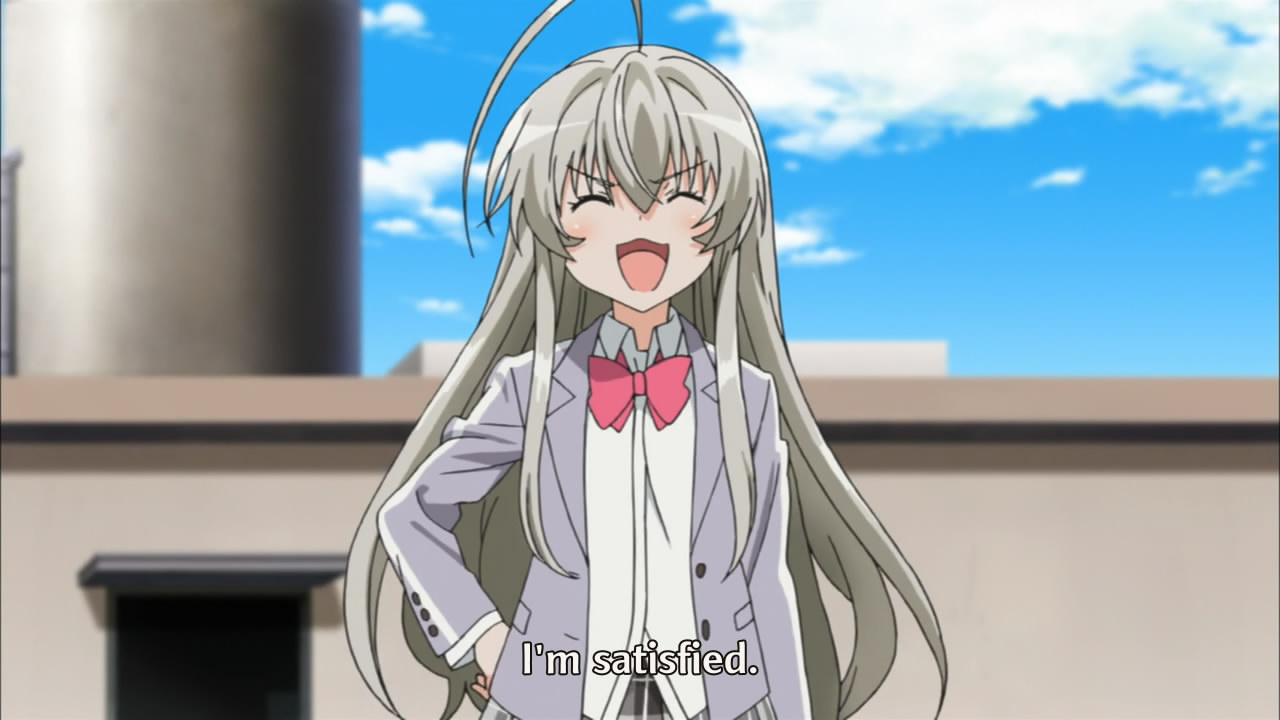
"I'm satisfied." (20:54)
The Japanese line is "Manzoku shita zo yo! Na ha ha ha!" (満足したぞよ、んなーっはっはっは!). Nyaruko's line and pose are referencing those of Cthylla (クティーラ) when she wins a round in "Chaos Code" (カオスコード), a fighting game developed by F K Digital and released by Arc System Works (アークシステムワークス in 2011.S1 On a related note, Cthylla is the daughter of Cthulhu in the Cthulhu Mythos. Video for reference: https://youtu.be/9UsmhnrYV1I?t=64
"It's an unspeakable bar-like thing." (21:07)
There are three references here:
* "Meijou shigatai" (名状しがたい), "Unspeakable", is a term that is often used in the Cthulhu Mythos.S2
* "Baaru no you na mono" (バールのようなもの), "Bar-like thing", is an expression used by the Japanese media to refer to a weapon in a criminal case when not much is known about it aside from the shape. Many people found it silly, and it eventually became a meme.S2
* Crowbar is a recurring weapon in the "Call of Cthulhu" RPG.S3 In "1920s Investigators' Companion", a "Call of Cthulhu" RPG guidebook published by Chaosium in 1993, the crowbar is listed as a weapon of convenience. Weapons of Convenience from "Investigators' Companion" for reference. In the d20 adaptation of "Call of Cthulhu", published by Wizards of the Coast in 2002, crowbar is listed as a medium-size bludgeoning weapon. Weapons Table from the "Call of Cthulhu" d20 edition rulebook for reference.
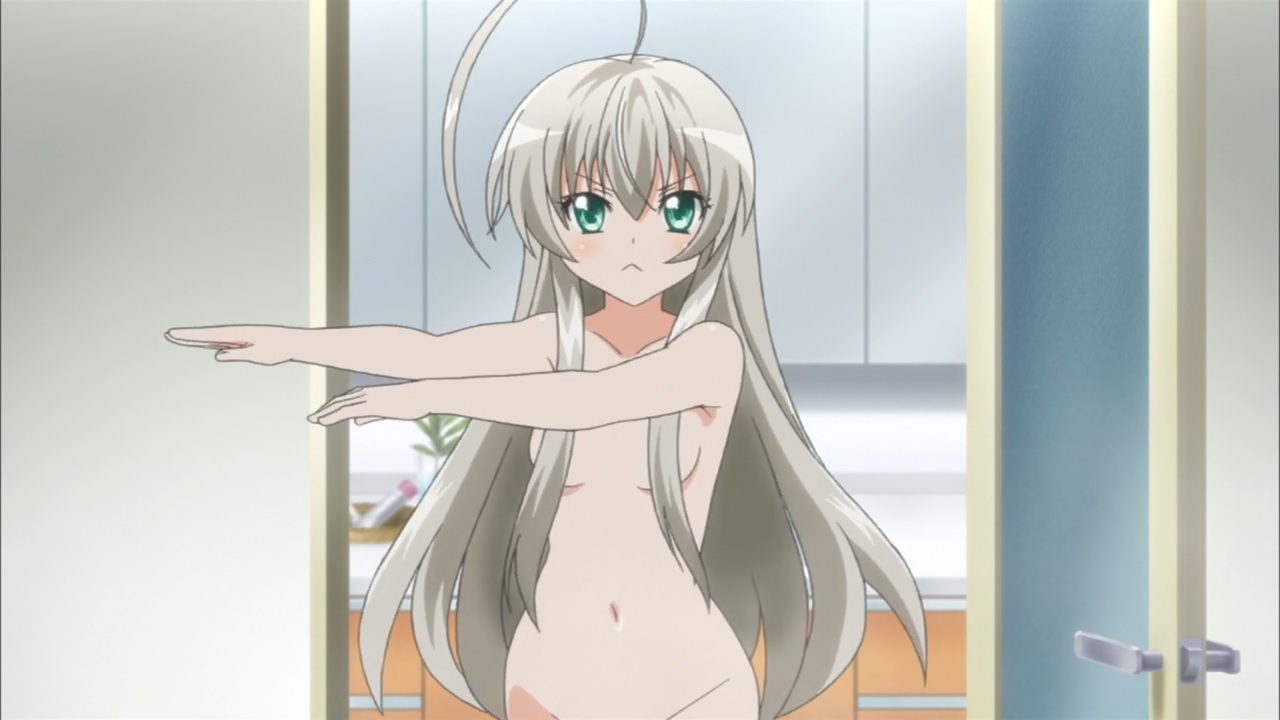
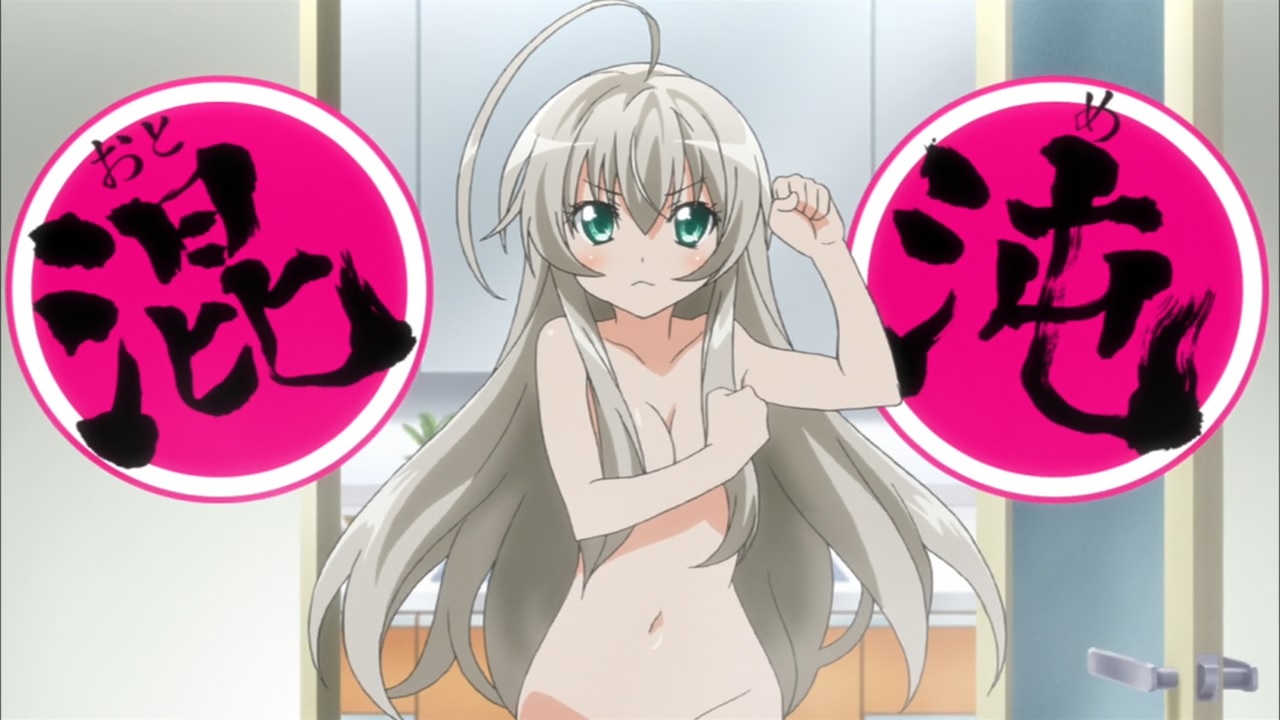
(21:30)
There are two references here:
* Nyaruko's poses are referencing those of Kamen Rider 2 from "Kamen Rider" (仮面ライダー). Images for reference:
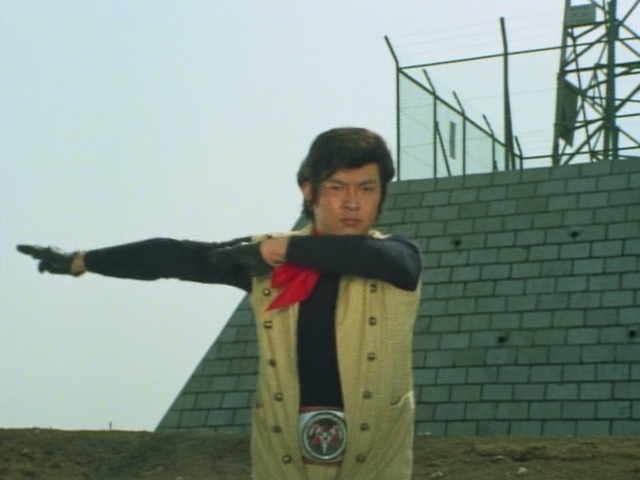
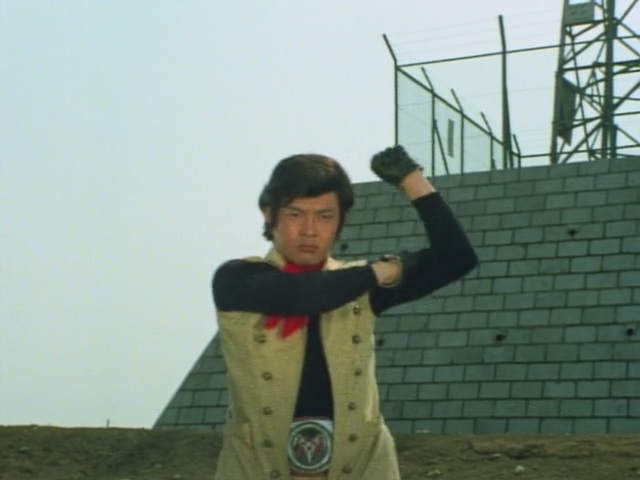
* Regarding the symbols, there are two large characters that read "kon" and "ton" (混沌) meaning "chaos", but there are also smaller characters above those that read "oto" and "me" (おとめ) meaning "maiden", stating that the text is written as "chaos" but is read as "maiden". This seems to be inspired by an adult game based on the Cthulhu Mythos and released by Cyc in 2010. The title of the game is 「ク・リトル・リトル~魔女(オトメ)の使役(フレ)る、蟲神(テンシ)の触手~」 (Ku Ritoru Ritoru ~Otome no Fureru, Tenshi no Yubisaki~), in which the characters 「魔女」, normally read as "majo" to mean "witch", are stated to be read as 「オトメ」 (otome), which means "maiden".S2
"Zakrello!" (22:05)
Nyaruko yelp #7. Zakrello (ザクレロ) is the name of a combat vehicle from "Mobile Suit Gundam" (機動戦士ガンダム).S9
List of sources:
S1. Commie Subs translators
S2. A post by convexity
S3. Comments on this post
S4. A post at Steman Blog (ステマブログ)
S5. Japanese Nyaruko References Wiki (這いよれ! ニャル子さん 元ネタwiki) - Nyaruko Episode 1
S6. Japanese Nyaruko References Wiki (這いよれ! ニャル子さん 元ネタwiki) - Nyaruko Light Novel Series Volume 1, Chapter 1
S7. Cthulhu Mythos References in Nyaruko Episode 1 by servitors
S8. Cthulhu Mythos References in Nyaruko Episode 3 by servitors
S9. A post by the reddit user RoyalGuard128
S10. A video posted by nicovideo user Taniiwa (タニーワ)
S11. A video posted by nicovideo user Kagetomo (かげとも)
S12. Red Worm Sanatorium
Thanks to everyone who contributed! This list wouldn't be nearly as long without you all. See you next episode!
情報を教えてくださって本当にありがとうございました!皆さんがいなかったら、このリストはぜんぜん長くありません。またこの次までね!
Last updated March 27, 2022
Sitemap
Home